Festool BPLI Wireless Vacuum Control System based on BTLE implemented within multiple devices User Manual OBJ BUCH 0000000961 001
Festool GmbH Wireless Vacuum Control System based on BTLE implemented within multiple devices OBJ BUCH 0000000961 001
Festool >
Contents
- 1. Users Manual_1
- 2. Users Manual_2
- 3. Users Manual_3
- 4. Users Manual_4
Users Manual_1
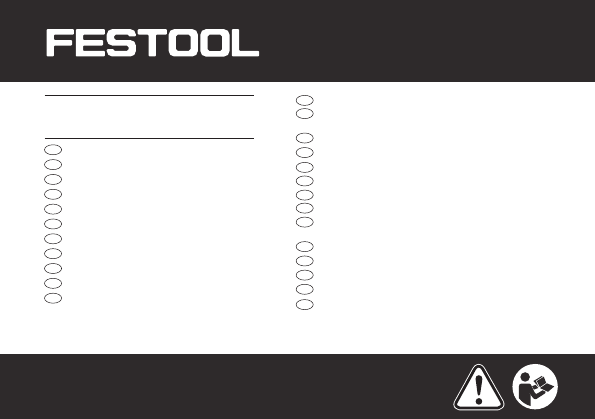
709393_002
Hinweise für Li-Ion Akkupacks
D
Instructions for Li-ion battery packs
GB
Consignes relatives aux batteries Li-Ion
F
BG
EST
HR
LV
LT
SLO
H
GR
SK
RO
TR
SRB
PL
CZ
BP 18 Li ASI
E
I
NL
S
FIN
DK
N
P
Indicaciones para baterías de litio
Avvertenze per le batterie agli ioni di litio
Instructies voor Li-ion accupacks
Anvisningar för Li-jonbatterier
Litiumioniakkuja koskevia ohjeita
Anvisninger for Li-ion-batterier
Informasjon om litium-ion-batterier
Indicações para acumuladores de LiIon
Pokyny pro lithium-iontové akumulátory
Wskazówki dotyczące użytkowania akumulatorów
litowo-jonowych
Указания за литиево-йонни акумулаторни батерии
Juhised liitiumioonakude juurde
Upute za akumulatorsku bateriju
Norādes par litija jonu akumulatoru bloku
Nurodymai dėl Li-Ion akumuliatorių
Navodila za litij-ionske akumulatorske baterije
Tudnivalók Li-ion akkumulátoregységekre
vonatkozóan
Υποδείξεις για µπαταρίες ιόντων λιθίου
Upozornenia pre lítium-iónové akumulátory
Indicaţii pentru pachetele de acumulatori LiIon
LiIon yedek aküler hakkında bilgiler
Napomene za litijum-jonska baterijska
pakovanja
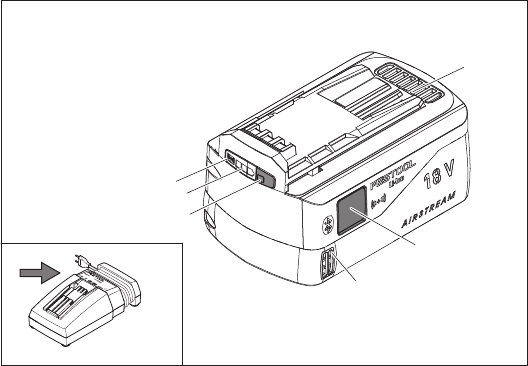
TCL 6
SCA 8
BP 18 Li ASI
1
1-4
1-3
1-4
1-5
1-2
1-1
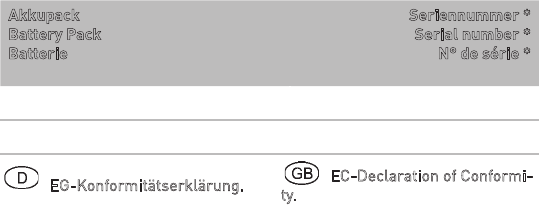
Akkupack
Battery Pack
Batterie
Seriennummer *
Serial number *
N° de série *
(T-Nr.)
BP 18 Li 5,2 ASI 10017087
BP 18 Li 6,2 ASI 10024639
EG-Konformitätserklärung.
Wir erklären in alleiniger Verant-
wortung, dass dieses Produkt allen
ein-schlägigen Bestimmungen der
folgenden Richtlinien einschließlich
ihrer Änderungen entspricht und
mit den folgenden Normen überein-
stimmt:
EC-Declaration of Conformi-
ty. We declare under our sole
responsibility that this product is in
conformity with all relevant
provisions of the following directives
including their amendments and
complies with the following
standards:
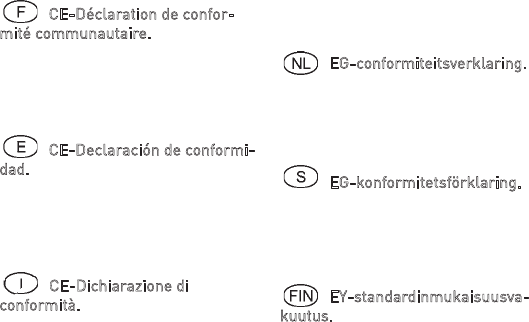
CE-Déclaration de confor-
mité communautaire. Nous
déclarons sous notre propre
responsabilité que ce produit est
conforme aux normes ou docu-
ments de normalisation suivants:
CE-Declaración de conformi-
dad. Declaramos bajo nuestra
exclusiva responsabilidad que este
producto corresponde a las
siguientes normas o documentos
normalizados:
CE-Dichiarazione di
conformità. Dichiariamo sotto la
nostra esclusiva responsabilità che
il presente prodotto e conforme alle
norme e ai documenti normativi
seguenti:
EG-conformiteitsverklaring.
Wij verklaren op eigen verantwoor-
delijkheid dat dit produkt voldoet
aan de volgende normen of
normatieve documenten:
EG-konformitetsförklaring. Vi
förklarar i eget ansvar, att denna
produkt stämmer överens med
följande normer och normativa
dokument:
EY-standardinmukaisuusva-
kuutus. Vakuutamme yksinvastuulli-
sina, etta tuote on seuraavien
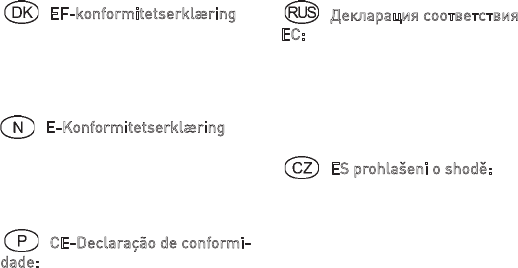
standardien ja normatiivisten
ohjeiden mukainen:
EF-konformitetserklæring Vi
erklærer at have alene ansvaret for,
at dette produkt er i overensstem-
melse med de følgende normer
eller normative dokumenter:
E-Konformitetserklæring Vi
erklærer på eget ansvar at dette
produktet er i overensstemmelse
med følgende normer eller
normative dokumenter:
CE-Declaração de conformi-
dade: Declaramos, sob a nossa
exclusiva responsabilidade, que este
produto corresponde às normas ou
aos documentos normativos citados
a seguir:
Декларация соответствия
ЕС: Мы заявляем с
исключительной
ответственностью, что данный
продукт соответствует следующим
нормам или нормативным
документам:
ES prohlašeni o shodě:
Prohlašujeme s veškerou odpověd-
nosti, že tento vyrobek je ve shodě s
nasledujicimi normami nebo
normativnimi dokumenty: .
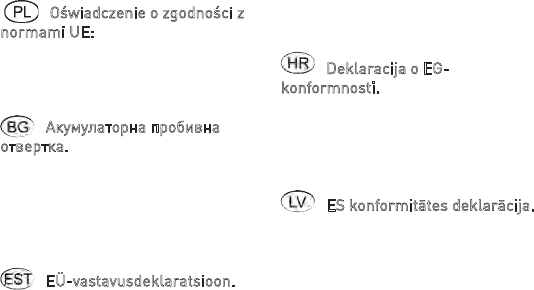
Oświadczenie o zgodności z
normami UE: Niniejszym oświadcz-
amy na własną odpowiedzialność,
że produkt ten spełnia następujące
normy lub dokumenty normatywne:
Акумулаторна пробивна
отвертка. Ние обявяваме с
еднолична отговорност, че този
продукт е съгласуван с всички
релевантни изисквания на
следните ръководни линии, норми
или нормативни документи:
EÜ-vastavusdeklaratsioon.
Kinnitame ainuvastutajatena, et
käesolev toode vastab järgmistele
standarditele ja
normdokumentidele:
Deklaracija o EG-
konformnosti. Izjavljujemo pod
vlastitom odgovornošću da je ovaj
proizvod u skladu sa svim važnim
zahtjevima sljedećih smjernica,
normi ili normativnih isprava:
ES konformitātes deklarācija.
Uzņemoties pilnu atbildību, mēs
apliecinām, ka šis produkts atbilst
šādām direktīvām, standartiem vai
normatīvajiem dokumentiem:
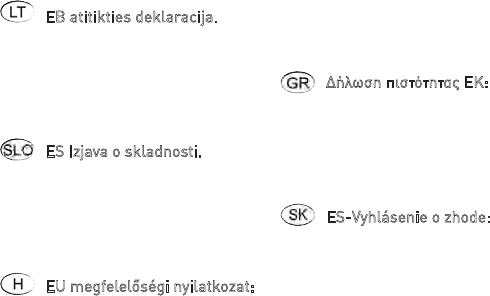
EB atitikties deklaracija.
Prisiimdami visą atsakomybę
pareiškiame, kad šis gaminys
tenkina visus aktualius šių
direktyvų, normų arba normatyvinių
dokumentų reikalavimus:
ES Izjava o skladnosti. S
polno odgovornostjo izjavljamo, da
je ta proizvod skladen z vsemi
veljavnimi zahtevami naslednjih
direktiv, standardov ali normativnih
dokumentov:
EU megfelelőségi nyilatkozat:
Kizárólagos felelõsségünk
tudatában kijelentjük, hogy ez a
termék az alábbi irányelvek,
szabványok vagy normatív
dokumentumok minden vonatkozó
követelményének megfelel:
Δήλωση πιστότητας ΕΚ:
Δηλώνουμε με αποκλειστική μας
ευθύνη, ότι αυτό το προϊόν ταυτίζεται
με όλες τις σχετικές απαιτήσεις των
ακόλουθων οδηγιών, προτύπων ή
εγγράφων τυποποίησης:
ES-Vyhlásenie o zhode:
Zodpovedne vyhlasujeme, že tento
produkt súhlasí so všetkými
relevantnými požiadavkami
nasledujúcich smerníc, noriem
alebo normatívnych dokumentov:
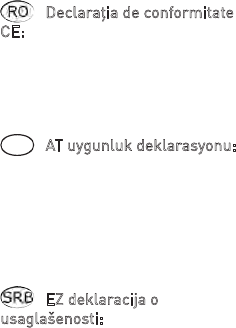
Declaraţia de conformitate
CE: Declarăm pe proprie
răspundere că acest produs este
conform cu toate cerinţele relevante
din următoarele directive, norme
sau documente normative:
TR AT uygunluk deklarasyonu:
Bütün sorumlulukları firmamıza ait
olmak kaydıyla bu ürünün aşağıda
açıklanan ilgili direktiflerin
yönetmeliklerini, norm ve norm
dokümanlarının koşullarını
karşıladığını taahhüt ederiz.
EZ deklaracija o
usaglašenosti: Mi izjavljujemo na
sopstvenu odgovornost da je ovaj
proizvod usklađen sa svim
______________________________
2014/53/EU, 2011/65/EU
EN 55014-1:2006 + A1:2009
+ A2:2011, EN 55014-2:2015,
EN 55015:2013 + A1:2015, EN
55020:2007, EN 55013:2013,
EN300328:2016 V2.1.1, EN 301489-
1:2017 V.2.1.1, EN301489-17:2017
V3.1.1, EN 50581: 2012
______________________________
relevantnim zahtevima sledece
direktive, standardima i
normativnim dokumentima:
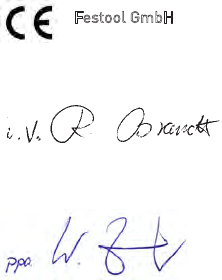
Festool GmbH
Wertstr. 20, D-73240
Wendlingen
GERMANY
Ralf Brandt
Head of Standardization & Appro-
bation
Wolfgang Zondler
Head of Research, Development and
Technical Documentation
718410_A
Wendlingen, 14.09.2017
* im definierten Seriennummer-Bereich
(S-Nr.) von 40000000 - 49999999
in the specified serial number range (S-
Nr.) from 40000000 - 49999999
dans la plage de numéro de série (S-Nr.)
de 40000000 - 49999999
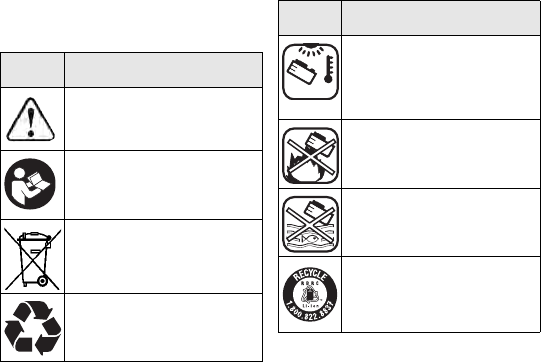
9
Hinweise für Li-Ion Akkupacks D
Hinweise für Li-Ion Akkupacks
1Symbole
Symbol Bedeutung
Warnung vor allgemeiner
Gefahr
Betriebsanleitung, Sicher-
heitshinweise lesen!
Nicht in den Hausmüll geben.
Recycling Symbol - wieder-
verwertbares Material
Einsatz und Lagerung des
Akkus nur im Temperaturbe-
reich von - 10 °C bis max. +
50 °C.
Vor Hitze und offenem Feuer
schützen – niemals ins Feuer
werfen –
Explosionsgefahr!
Vor Wasser schützen – nicht
in Flüssigkeiten tauchen.
RBRC Siegel - LiIon
Symbol Bedeutung
max. 50°C

D Hinweise für Li-Ion Akkupacks
10
2 Sicherheitshinweise für Li-
Ion Akkupacks
Warnung! Lesen Sie alle Si-
cherheitshinweise und Anwei-
sungen.
Versäumnisse bei der
Einhaltung der Sicherheitshinweise und
Anweisungen können elektrischen
Schlag, Brand und/oder schwere Verlet-
zungen verursachen.
Bewahren Sie alle Sicherheitshinweise
und Anleitungen für die Zukunft auf.
Zellen in Lithium-Ionen Akkupacks sind
gasdicht verschlossen und unschädlich,
sofern bei Gebrauch und Handhabung die
Herstellervorschriften eingehalten wer-
den.
–
Entladene Batterien vorsichtig be-
handeln. Akkupacks stellen eine Ge-
fahrenquelle dar, da sie einen sehr
hohen Kurzschlussstrom verursa-
chen können.
Selbst wenn sich Li-Ion
Akkupacks scheinbar in entladenem
Zustand befinden, entladen sich diese
nie vollständig.
–
Physische Schläge/Einwirkungen
vermeiden. Schläge und Eindringen
von Gegenständen können die Batte-
rien beschädigen.
Dies kann zu Leck-
agen, Hitzeentwicklung,
Rauchentwicklung, Entzündung oder
Explosion des Akkupacks führen.
–
Halten Sie den nicht benutzten Akku-
pack fern von Metallgegenständen
(z.B. Nägel, Schrauben, Schlüssel,
Büroklammern o.ä.), die eine Über-
brückung der Kontakte verursachen
könnten.
Ein Kurzschluss zwischen
11
Hinweise für Li-Ion Akkupacks D
den Akkukontakten kann Verbrennun-
gen oder Feuer zur Folge haben.
–
Akkupack vor Hitze z.B. auch vor
dauernder Sonneneinstrahlung und
Feuer schützen.
Feuer und Tempera-
turen über 130°C können Explosionen
hervorrufen.
–
Öffnen Sie den Akkupack nicht. Öff-
nen oder Verändern des Akkupacks
kann die Schutzvorkehrungen be-
schädigen.
Dies kann zu Hitzeent-
wicklung, Rauchentwicklung,
Entzündung oder Explosion des Akku-
packs führen.
–
Akkupack nicht in Flüssigkeiten, wie
(Salz-)Wasser oder Getränke tau-
chen. Kontakt mit Flüssigkeiten kann
den Akkupack beschädigen.
Dies
kann zu Hitzeentwicklung, Rauchent-
wicklung, Entzündung oder Explosion
des Akkupacks führen. Den Akkupack
nicht weiter verwenden und an einen
autorisierten Festool-Kundendienst
wenden.
–
Laden Sie die Akkupacks nur in Lade-
geräten auf, die vom Hersteller emp-
fohlen werden (siehe Abbildung).
Für
ein Ladegerät, das für eine bestimmte
Art von Akkupacks geeignet ist, be-
steht Brandgefahr, wenn es mit ande-
ren Akkupacks verwendet wird.
–
Brennende Li-Ion Akkupacks nie mit
Wasser löschen!
Sand oder Feuerlö-
schdecke verwenden.
–
Bei Beschädigung und unsachgemä-
ßem Gebrauch des Akkupacks kön-
D Hinweise für Li-Ion Akkupacks
12
nen Dämpfe austreten.
Die Dämpfe
können die Atemwege reizen. Führen
Sie Frischluft zu und suchen Sie bei
Beschwerden einen Arzt auf.
–
Verwenden Sie den Akkupack nur in
Verbindung mit Ihrem Festool Elekt-
rowerkzeug.
Nur so wird der Akku-
pack vor gefährlicher Überlastung
geschützt. Die Nutzung eines anderen
Werkzeugs kann zu Verletzungen und
Brandgefahr führen.
–
Bei falscher Anwendung kann Flüs-
sigkeit aus dem Akkupack austreten.
Vermeiden Sie den Kontakt damit.
Bei zufälligem Kontakt mit Wasser
abspülen. Wenn die Flüssigkeit in die
Augen kommt, nehmen Sie zusätzlich
ärztliche Hilfe in Anspruch.
Austre-
tende Akkuflüssigkeit kann zu Hau-
treizungen oder Verbrennungen
führen.
–
Bei defektem Akkupack kann Flüs-
sigkeit austreten und angrenzende
Gegenstände benetzen.
Überprüfen
Sie betroffene Teile. Reinigen Sie die-
se, indem Sie die Flüssigkeit mit ei-
nem trockenen Haushaltspapier
aufsaugen und mit reichlich Wasser
nachspülen. Vermeiden Sie Hautkon-
takt durch Tragen von Schutzhand-
schuhen. Tauschen Sie die Teile
gegebenenfalls aus.
–
Beschädigte oder veränderte Akku-
packs nicht verwenden.
Beschädigte
oder veränderte Akkupacks können
nicht vorhersehbare Eigenschaften
aufweisen, die zu Feuer, Explosion

13
Hinweise für Li-Ion Akkupacks D
oder Verletzungen führen.
–
Den Akkupack nicht öffnen, zerdrü-
cken, überhitzen (über 80°C) oder
verbrennen.
Bei Missachtung besteht
Verbrennungs- und Brandgefahr. Fol-
gen Sie den Anweisungen des Her-
stellers.
–
Beschädigte Akkupacks nicht ver-
wenden. Die Nutzung eines Akku-
packs muss sofort gestoppt werden,
sobald dieser anormale Eigenschaf-
ten aufweist, wie Geruchsentwick-
lung, Hitze, Verfärbung oder
Verformung.
Bei fortgesetztem Be-
trieb kann der Akkupack Hitze und
Rauch entwickeln, sich entzünden
oder explodieren.
3 Technische Daten
Weitere technische Daten siehe Leis-
tungsschild am Akkupack.
Akkupack BP 18 Li
Frequenz 2402 Mhz – 2480 Mhz
Äquivalente
isotrope Strah-
lungsleistung
(EIRP)
<10 dBm

D Hinweise für Li-Ion Akkupacks
14
4 Bestimmungsgemäße Ver-
wendung
Akkupacks sind geeignet zur Verwendung
mit Festool Akku-Elektrowerkzeugen und
den angegebenen Festool Ladegeräten
(siehe Abbildung).
Der Akkupack ist zum automatischen Ein-
/Ausschalten des Absaugmobils geeignet.
5 Geräteelemente
Die angegebenen Abbildungen* befinden
sich am Anfang der Betriebsanleitung.
* Abbildungen können vom Original ab-
weichen.
6 Betrieb
[1-1]
Taste Kapazitätsanzeige
[1-2]
Kapazitätsanzeige
[1-3]
Bluetooth-Anzeige
[1-4]
Lüftungsöffnungen (nur BP 18 Li
... ASI)
[1-5]
Tasten zum Lösen des Akkupacks
VORSICHT
Verletzungsgefahr, unerwarteter Anlauf
Absaugmobil
Vor allen Arbeiten mit dem Absaugmobil
prüfen, welcher Akkupack mit dem Ab-
saugmobil verbunden ist.

15
Hinweise für Li-Ion Akkupacks D
6.1 Hinweise für den optimalen Um-
gang mit dem Akkupack
Der Akkupack wird teilgeladen aus-
geliefert. Um die volle Leistung des
Akkupacks zu gewährleisten, vor
dem ersten Einsatz den Akkupack
vollständig im Ladegerät aufladen.
Der Akkupack kann jederzeit aufgeladen
werden, ohne die Lebensdauer zu verkür-
zen. Eine Unterbrechung des Ladevor-
ganges schädigt den Akkupack nicht.
Nach dem automatischen Ab-
schalten des Elektrowerkzeugs
nicht weiter auf den Ein-/Aus-
schalter drücken.
Der Akku-
pack kann beschädigt werden.
Der Akkupack ist mit einer Temperaturü-
berwachung ausgestattet, welche ein Aufla-
den nur im Temperaturbereich zwischen 0
°C und 55 °C zulässt. Dadurch wird eine
hohe Akku-Lebensdauer erreicht.
– Akkupack möglichst kühl (5 °C bis
25 °C) und trocken (Luftfeuchte < 80%)
lagern.
– Akkupack z.B. im Sommer nicht im
Auto liegen lassen.
– Eine wesentlich verkürzte Betriebs-
zeit nach der Aufladung zeigt an, dass
der Akkupack verbraucht ist und er-
setzt werden muss.
– Hinweise zur Entsorgung beachten.
6.2 Kapazitätsanzeige
Die Kapazitätsanzeige
[1-2]
zeigt bei Be-
tätigung der Taste Kapazitätsanzeige
[1-
1]
den Ladezustand des Akkupacks an:
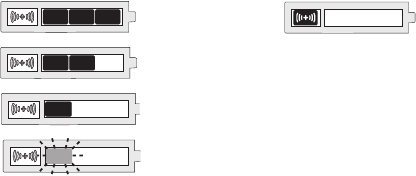
D Hinweise für Li-Ion Akkupacks
16
6.3 Bluetooth-Funktionen
Neben der Kapazitätsanzeige befindet
sich die Bluetooth-Anzeige
[1-3]
, die den
Verbindungsstatus des Akkupacks an-
zeigt:
70 - 100 %
40 - 70 %
15 - 40 %
< 15 %
Empfehlung:
Akkupack vor
weiterer Verwen-
dung laden.
blaues Dauer-
licht
Akku-Elektro-
werkzeug läuft
und Absaugmo-
bil ist über
Bluetooth ver-
bunden oder der
Akkupack ist
mit einem
mobilen Endge-
rät verbunden

17
Hinweise für Li-Ion Akkupacks D
Der Akkupack verwendet Bluetooth,
um entsprechend ausgestattete Ab-
saugmobile bei der Verwendung mit
einem Akku-Elektrowerkzeug auto-
matisch zu schalten.
Akkupack mit Absaugmobil verbinden
Das Absaugmobil kann gleichzeitig
mit nur einem Akku-Elektrowerk-
zeug verbunden werden.
Wenn das Absaugmobil initial mit
dem Akkupack eingeschaltet wurde
und mit der Fernbedienung ausge-
schaltet wird, verliert ein verbunde-
ner Akkupack seine temporäre Ver-
bindung zum Absaugmobil. An-
schließend kann der Akkupack neu
verbunden werden.
Den Automatik-Modus des Absaugmo-
bils aktivieren (siehe Betriebsanleitung
Absaugmobil).
Wenn das Akku-Elektrowerkzeug be-
reits in Betrieb war, sicherstellen dass
die Kapazitätsanzeige des Akkupacks
erloschen ist, damit das Verbinden
möglich ist (kann in Einzelfällen meh-
rere Sekunden dauern).
pulsierend blau
Akkupack ist
bereit für eine
Verbindung mit
dem mobilen
Endgerät (z.B.
Softwareupdate)
D Hinweise für Li-Ion Akkupacks
18
Die Verbindungstaste am Absaugmobil
oder an der Fernbedienung einmal drü-
cken.
Die LED am Nachrüst-Empfangs-
modul blinkt langsam rotierend blau
und das Absaugmobil ist für 60 Se-
kunden verbindungsbereit.
Das Akku-Elektrowerkzeug einschal-
ten.
Das Absaugmobil läuft an und der
Akkupack ist bis zum manuellen
Ausschalten des Absaugmobils ver-
bunden.
Wenn ein zweiter Akkupack mit dem
Absaugmobil verbunden wird, wird
die Verbindung des ersten Akku-
packs getrennt.
Ein-/Ausschalten des Absaugmobils
Nach dem Verbindungsaufbau von Akku-
pack und Absaugmobil läuft das Absaug-
mobil bei der Verwendung des Akku-
Elektrowerkzeugs automatisch mit an.
Wenn das Absaugmobil über den
Akkupack ausgeschaltet wird, läuft
es bis zu fünfzehn Sekunden nach.
Den Ein-/Ausschalter des Akku-Elekt-
rowerkzeugs drücken, um das Absaug-
mobil einzuschalten.
Den Ein-/Ausschalter des Akku-Elekt-
rowerkzeugs loslassen, um das Ab-
saugmobil auszuschalten.
19
Hinweise für Li-Ion Akkupacks D
Akkupack vom Absaugmobil trennen
Um die Verbindung von Akkupack und Ab-
saugmobil zu trennen, führen Sie einen
der folgenden Schritte aus:
– Absaugmobil stromlos schalten
– Akkupack auf Ladegerät aufsetzen
– Anderen Akkupack mit Absaugmobil
verbinden
Verbinden eines mobilen Endgeräts
Der Akkupack kann in Verbindung mit ei-
nem mobilen Endgerät genutzt werden (z.
B. für ein Softwareupdate mit der Festool-
App).
Die Taste Kapazitätsanzeige
[1-1]
drü-
cken, bis die Bluetooth-Anzeige
[1-3]
blau pulsiert.
Der Akkupack ist für 60 Sekunden
verbindungsbereit.
Den Anweisungen in der Festool-App
folgen.
7 Wartung und Pflege
Die Anschlusskontakte am Akkupack
sauber halten.
Die Lüftungsöffnungen
[1-4]
am Akku-
pack offen halten, sonst eingeschränk-
te Funktion.
Ist der Akkupack nicht mehr funktions-
fähig, an einen autorisierten Festool-
Kundendienst wenden.
(
www.festool.com/service
)
8Transport
Die enthaltenen Li-Ion Akkupacks unter-
liegen den Anforderungen des Gefahrgut-
beförderungsgesetzes. Die Festool Li-Ion
Akkupacks erfüllen die nach UN-Hand-
D Hinweise für Li-Ion Akkupacks
20
buch ST/SG/AC.10/11/Rev.5 Teil III, Unter-
abschnitt 38.3. genannten Voraussetzun-
gen. Der Benutzer kann Festool Akku-
packs beim Straßentransport ohne
weitere Auflagen zum Einsatzort des Ge-
rätes mitführen, vorausgesetzt sie sind
gegen Kurzschluss geschützt und gegen
Verrutschen gesichert. Beim Versand
durch Dritte (z.B.: Lufttransport oder Spe-
dition) sind besondere Anforderungen an
Verpackung und Kennzeichnung zu be-
achten. Bei der Vorbereitung des Ver-
sandstückes muss eine in den Gefahrgut-
vorschriften unterwiesene Person hinzu-
gezogen werden. Bitte beachten Sie
eventuelle weiterführende nationale Vor-
schriften.
Den Akkupack nur versenden, wenn das
Gehäuse unbeschädigt ist. Offene Kontak-
te abkleben und Akkupack so verstauen,
dass er sich nicht in der Verpackung be-
wegen kann.
9 Umwelt
Verbrauchte oder defekte Akkupacks
nur entladen und gegen Kurzschluss ge-
sichert (z.B. durch das Isolieren der Pole
mit Klebestreifen) bei den Rücknahme-
stellen zurückgeben (geltende Vorschrif-
ten beachten).
Akkupacks werden so einem geordneten
Recycling zugeführt.
Nur EU:
Gemäß Europäischer Richtlinie
über Batterien und Akkumulatoren und
Umsetzung in nationales Recht müssen
defekte oder verbrauchte Akkupacks/
Batterien getrennt gesammelt und einer

21
Hinweise für Li-Ion Akkupacks D
umweltgerechten Wiederverwertung zu-
geführt werden.
Informationen zur REACh:
www.festool.com/reach
"Die Bluetooth®" Wortmarke und -Logos
sind eingetragene Warenzeichen der
Bluetooth SIG, Inc. und jede Verwendung
dieser Marken durch die Festool GmbH
erfolgt unter Lizenz.
Informationen zum Datenschutz
Das Elektrowerkzeug enthält einen Chip
zur automatischen Speicherung von Ma-
schinen- und Betriebsdaten. Die gespei-
cherten Daten enthalten keinen direkten
Personenbezug.
Die Daten können mit speziellen Geräten
kontaktlos ausgelesen werden, und wer-
den von Festool ausschließlich zur Feh-
lerdiagnose, Reparatur- und Garantieab-
wicklung sowie zur Qualitätsverbesse-
rung bzw. Weiterentwicklung des
Elektrowerkzeugs verwendet. Eine darü-
ber hinausgehende Nutzung der Daten –
ohne ausdrückliche Einwilligung des
Kunden – erfolgt nicht.
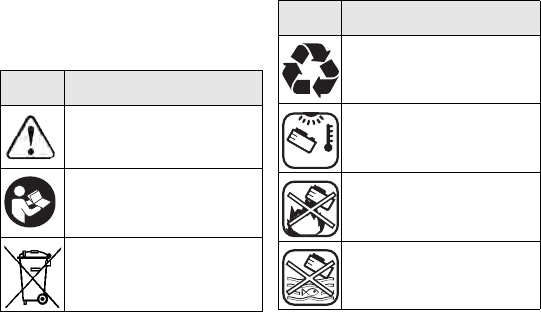
GB Instructions for Li-ion battery packs
22
Instructions for Li-ion battery
packs
1Symbols
Symbol Significance
Warning of general danger
Read operating instructions
and safety notices!
Do not dispose of as domestic
waste.
Recycling symbol – recycla-
ble material
Only use and store the battery
at temperatures of between -
10 °C and +50 °C.
Keep away from heat and
open flames – never throw
into a fire –
risk of explosion.
Keep away from water – do
not immerse in liquids.
Symbol Significance
max. 50°C
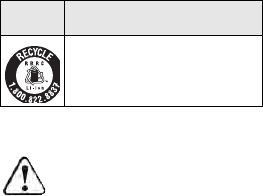
23
Instructions for Li-ion battery packs GB
2 Safety information for Li-ion
battery packs
Warning! Read and observe all
information and safety instruc-
tions.
Failure to observe the
safety guidelines and instructions may
lead to electric shocks, fires and/or seri-
ous injuries.
Keep all safety information and other in-
structions in a safe place for future ref-
erence.
Cells in lithium-ion battery packs are
sealed so as to be gas-tight and are non-
hazardous provided they are used and
handled in accordance with the manufac-
turer's instructions.
–
Handle discharged batteries with
care. Battery packs represent a safe-
ty hazard as they can cause a very
high short circuit current.
Even if Li-
ion battery packs appear to be dis-
charged, they are in fact never fully
discharged.
–
Make sure that the battery pack is not
subjected to physical blows or im-
pacts. Impacts and penetrating ob-
jects may damage the batteries.
This
may lead to leakages, the generation
of heat or smoke, or cause the battery
RBRC Seal - LiIon
Symbol Significance
GB Instructions for Li-ion battery packs
24
pack to ignite or explode.
–
Keep the unused battery pack away
from paper clips, coins, keys, nails,
screws and other small metal objects
which could bridge the contacts.
A
short circuit between the battery con-
tacts poses a risk of burns or fire
–
Protect the battery pack from exces-
sive heat or constant heat sources
such as sunlight or naked flames.
Fire and temperatures over 130 °C
may cause explosions.
–
Do not open the battery pack. Open-
ing or modifying the battery pack may
damage the protective devices.
This
may lead to the generation of heat or
smoke, or cause the battery pack to
ignite or explode.
–
Do not immerse the battery pack in
liquids such as (salt) water or drinks.
Contact with liquids may damage the
battery pack.
This may lead to the
generation of heat or smoke, or cause
the battery pack to ignite or explode.
Do not continue using the battery
pack. Consult an authorised Festool
customer service agent.
–
Only charge the battery packs in
chargers recommended by the man-
ufacturer (see image).
There is a risk
of fire when using a charger which is
meant for a specific type of battery
pack with a different battery pack.
–
Never use water to extinguish burn-
ing Li-ion battery packs; always use
25
Instructions for Li-ion battery packs GB
sand
or a fire blanket.
–
There is a risk of vapours being re-
leased if the battery pack is damaged
or not used correctly.
The vapours
could irritate your airways. Seek fresh
air and consult a doctor if you feel un-
well.
–
Only use the battery pack in conjunc-
tion with your Festool power tool.
This is the only way to ensure that the
battery pack is protected against a
dangerous overload. Using a different
tool poses a fire hazard and may cause
personal injury.
–
Fluid may leak out of the battery pack
if it is used incorrectly. Avoid contact
with the fluid. Rinse with water any
areas which accidentally come into
contact with the fluid. If fluid gets into
the eyes, also consult a doctor.
Leak-
ing battery fluid can cause skin irrita-
tion or burns.
–
Fluid may leak out of a faulty battery
pack and contaminate neighbouring
objects.
Check the parts affected.
Clean them by soaking up the fluid us-
ing dry kitchen towel and then rinsing
with plenty of water. Wear protective
gloves to avoid contact with the fluid.
Replace the parts if necessary.
–
Do not use damaged or modified bat-
tery packs.
Battery packs which are
damaged or which have been modified
may exhibit unpredictable behaviour
which could lead to fire, explosion or

GB Instructions for Li-ion battery packs
26
injury.
–
Do not open, compress, overheat
(above 80 °C) or burn the battery
pack.
Failure to observe these precau-
tions is a fire hazard and may result in
burns. Observe the manufacturer's in-
structions.
–
Do not use damaged battery packs.
Stop using a battery pack immediate-
ly if you notice anything unusual such
as odour formation, the generation of
heat, discolouration or deformation.
If you continue to use the battery pack,
it may get hot, emit smoke, ignite or
explode.
3Technical data
For further technical specifications see
the rating plate on the battery pack.
4 Intended use
Battery packs are suitable for use with
Festool cordless power tools and the
specified Festool chargers (see image).
Battery pack BP 18 Li
Frequency 2402–2480 Mhz
Equivalent Iso-
tropically Radi-
ated Power
(EIRP)
< 10 dBm

27
Instructions for Li-ion battery packs GB
The battery pack is suitable for automati-
cally switching the mobile dust extractor
on and off.
5 Machine features
The specified illustrations* appear at the
beginning of the operating instructions.
* Illustrations may deviate from the origi-
nal.
6Operation
6.1 Information for making optimal
use of the battery pack
The battery pack is delivered partial-
ly charged. To guarantee that the
battery pack provides full power,
[1-1]
Capacity indicator button
[1-2]
Capacity display
[1-3]
Bluetooth indicator
[1-4]
Vent holes (only BP 18 Li ... ASI)
[1-5]
Buttons for releasing the battery
pack
CAUTION
Risk of injury from the mobile dust ex-
tractor starting up unexpectedly
Before performing any work with the
mobile dust extractor, check which
battery pack is connected to the mobi-
le dust extractor.
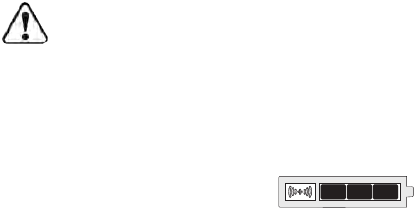
GB Instructions for Li-ion battery packs
28
charge it completely in the charger
before using it for the first time.
The battery pack can be charged at any
time without reducing the battery life. In-
terrupting the charging process does not
damage the battery pack.
After the power tool has
switched off automatically, do
not press the on/off button.
This could damage the battery
pack.
The battery pack is fitted with a
temperature sensor, which only permits
charging at temperatures of between 0 °C
and 50 °C. This ensures a longer battery
life.
– The battery pack should ideally be
stored in a cool (5 °C to 25 °C) and dry
location (air humidity < 80%).
– Do not, for instance, leave the battery
pack in the car in the summer.
– Significantly shorter operating times
after each charge indicate that the
battery pack is worn and should be re-
placed with a new one.
– Observe the information regarding
disposal.
6.2 Capacity display
When the capacity indicator button
[1-1]
is pressed, the capacity indicator
[1-2]
displays the charge status of the battery
pack:
70 - 100%

29
Instructions for Li-ion battery packs GB
6.3 Bluetooth functions
The Bluetooth indicator
[1-3]
, which indi-
cates the connection status of the battery
pack, is located next to the capacity indi-
cator:
40 - 70%
15 - 40%
< 15%
Recommenda-
tion:
Charge bat-
tery pack before
further use.
Continuous blue
light
Cordless power
tool starts up and
the mobile dust
extractor is con-
nected via Blue-
tooth or the
battery pack is
connected to a
mobile terminal

GB Instructions for Li-ion battery packs
30
The battery pack uses Bluetooth to
automatically switch correspond-
ingly equipped mobile dust ex-
tractors when used with a cordless
power tool.
Connecting the battery pack to the mo-
bile dust extractor
The mobile dust extractor can only
be connected to one cordless power
tool at any time.
If a mobile dust extractor which was
initially switched on using the bat-
tery pack is switched off using the
remote control, the temporary con-
nection between the connected bat-
tery pack and the mobile dust ex-
tractor will be lost. The battery pack
can then be connected again.
Activate the mobile dust extractor's au-
tomatic mode (see the operating in-
structions for the mobile dust ex-
tractor).
Pulsating blue
light
The battery pack
is ready for con-
nection to the
mobile terminal
(e.g. for a soft-
ware update)
31
Instructions for Li-ion battery packs GB
Should you have used the cordless pow-
er tool already, ensure that the battery
pack's capacity indicator has gone out
so that you can connect it (in certain
cases this can take a few seconds).
Press the connection button on the mo-
bile dust extractor or on the remote
control once. <PosNumber/>
The LED on the retrofit receiver
module slowly flashes blue and the
mobile dust extractor is ready for
connection for 60 seconds.
Switch on the cordless power tool.
The mobile dust extractor starts up
and the battery pack is connected
until the mobile dust extractor is
manually switched off.
If a second battery pack is connected
to the mobile dust extractor, the con-
nection to the first battery pack is
lost.
Switching the mobile dust extractor on
and off
Once you have connected the battery pack
with the mobile dust extractor, the mobile
dust extractor will start up automatically
when the cordless power tool is in use.
After the mobile dust extractor has
been switched off via the battery
pack, it will continue to run for up to
fifteen seconds.
Press the on/off switch of the cordless
power tool to switch on the mobile dust
extractor.
GB Instructions for Li-ion battery packs
32
Release the on/off switch of the cord-
less power tool to turn off the mobile
dust extractor.
Disconnecting the battery pack from the
mobile dust extractor
To disconnect the battery pack from the
mobile dust extractor, take one of the fol-
lowing steps:
– Disconnect the mobile dust extractor
– Put the battery pack on the charger
– Connect another battery pack to the
mobile dust extractor
Connecting a mobile terminal
The battery pack can be used in connec-
tion with a mobile terminal (e.g. for a soft-
ware update with the Festool app).
Press the capacity indicator button
[1-
1]
until the Bluetooth indicator
[1-3]
flashes blue.
The battery pack is ready for con-
nection for 60 seconds.
Follow the instructions provided in the
Festool app.
7 Service and maintenance
Keep the connecting contacts on the
battery pack clean.
Do not cover the vents
[1-4]
on the bat-
tery pack as this could impair its func-
tion.
If the battery pack stops working, con-
sult an authorised Festool customer
service agent.
(
www.festool.com/service
)
33
Instructions for Li-ion battery packs GB
8Transport
The Li-ion battery packs included are sub-
ject to the requirements of the legislation
on the transport of hazardous goods. The
Festool Li-ion battery packs satisfy the re-
quirements specified in the UN manual
ST/SG/AC.10/11/Rev.5 Part III, sub-sec-
tion 38.3. The user can transport Festool
battery packs by road to the equipment
operating site without any additional re-
quirements, provided they are protected
against short-circuiting and slipping. For
shipping by third parties (e.g. air transport
or freight forwarding company) special re-
quirements with regard to packaging and
labelling must be observed. When prepar-
ing the item to be sent, you must consult
an expert in hazardous goods regulations.
Please observe any further national regu-
lations.
Only return the battery pack if the housing
is undamaged. Tape over the exposed
contacts and wrap the battery pack so that
it cannot move inside the packaging.
9 Environment
Used or defective battery packs
may only
be returned to collection points if dis-
charged and secured against short-circu-
iting (e.g. by insulating the terminals with
adhesive tape). The applicable regulations
must be observed.
Battery packs will then be recycled.
EU only:
In accordance with the European
Directive on batteries and implementation
in national law, defective or used battery
packs/batteries must be collected sepa-

GB Instructions for Li-ion battery packs
34
rately and handed in for environmentally
friendly recycling.
Information on REACh:
www.festool.com/
reach
"The Bluetooth®" word mark and logos
are registered trademarks owned by
Bluetooth SIG, Inc. and any use of such
marks by Festool GmbH is under license.
Information on data protection
The power tool contains a chip which au-
tomatically stores machine and operating
data. The data saved cannot be traced
back directly to an individual.
The data can be read using special (con-
tactless) devices and shall only be used by
Festool for fault diagnosis, repair and
warranty processing and for quality im-
provement or enhancement of the power
tool. The data shall not be used in any oth-
er way without the express consent of the
customer.
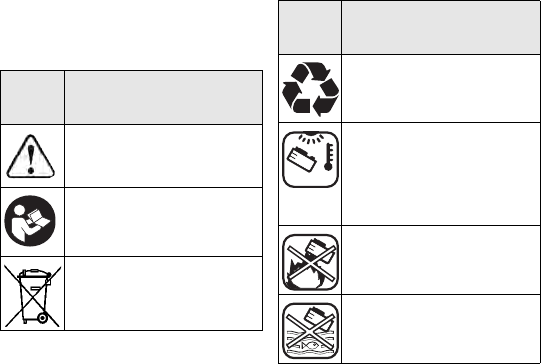
35
Consignes relatives aux batteries Li-Ion F
Consignes relatives aux batte-
ries Li-Ion
1Symboles
Sym-
bole
Signification
Avertissement de danger
Notice d'utilisation, lire les
consignes de sécurité !
Ne pas jeter l'appareil avec
les ordures ménagères.
Symbole de recyclage -
matériau réutilisable
Utilisation et stockage de la
batterie uniquement dans
une plage de température
comprise entre - 10 °C et
max. + 50 °C.
Protéger de la chaleur et du
feu – ne jamais jeter au feu –
risque d'explosion !
Protéger de l'eau – ne pas
plonger dans un liquide.
Sym-
bole
Signification
max. 50°C
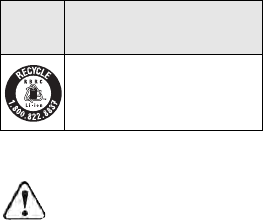
F Consignes relatives aux batteries Li-Ion
36
2 Consignes de sécurité pour
les batteries Li-Ion
Avertissement ! Veuillez lire
toutes les consignes de sécuri-
té et instructions.
Des négli-
gences relatives aux consignes de sécuri-
té et aux instructions peuvent occasion-
ner un choc électrique, un incendie et/ou
des blessures graves.
Conserver toutes les consignes de sécu-
rité et notices d'instructions pour une ré-
férence future.
Les cellules dans les batteries lithium-ion
sont conservées de manière étanche aux
gaz et sont inoffensives dans la mesure où
les prescriptions du fabricant sont res-
pectées pendant leur utilisation et leur
maniement.
–
Manipuler les batteries déchargées
avec précaution. Les batteries repré-
sentent une source de danger étant
donné qu'elles peuvent causer un
courant de court-circuit très élevé.
Même si les batteries Li-ion semblent
être déchargées, elles ne se dé-
chargent jamais entièrement.
–
Éviter tout choc/influence physique.
RBRC Sceau - LiIon
Sym-
bole
Signification
37
Consignes relatives aux batteries Li-Ion F
Les coups et la pénétration d'objets
peuvent endommager les batteries.
Cela peut entraîner des fuites, un dé-
gagement de chaleur, un dégagement
de fumée, un inflammation ou une ex-
plosion de la batterie.
–
Éloignez la batterie non utilisée des
trombones, pièces de monnaie, clés,
clous, vis ou tout autre objet métal-
lique qui pourraient causer un pon-
tage des contacts.
Un court-circuit
entre les contacts de la batterie peut
causer des brûlures ou prendre feu.
–
Protégez la batterie contre la cha-
leur, p. ex. également contre les
rayons de soleil permanents ou le
feu.
Le feu et des températures supé-
rieures à 130°C peuvent causer des
explosions.
–
Ne pas ouvrir la batterie. Le fait d'ou-
vrir ou de modifier la batterie peut
entraver les mesures de protection.
Cela peut entraîner un dégagement de
chaleur, un dégagement de fumée,
une inflammation ou une explosion de
la batterie.
–
Ne pas plonger la batterie dans des
liquides tels que l'eau (salée) ou des
boissons. Le contact avec des li-
quides peut endommager la batterie.
Cela peut entraîner un dégagement de
chaleur, un dégagement de fumée,
une inflammation ou une explosion de
la batterie. Ne plus utiliser la batterie
et s'adresser au Service Après-Vente
F Consignes relatives aux batteries Li-Ion
38
Festool.
–
Rechargez les batteries uniquement
dans les chargeurs recommandés
par le fabricant (voir figure).
Un char-
geur destiné à un certain type de bat-
teries peut prendre feu s'il est utilisé
avec d'autres batteries.
–
N'utiliser en aucun cas de l'eau pour
éteindre une batterie "Li-ion" en-
flammée
, utiliser du
sable
ou une
couverture anti-feu.
–
En cas d'endommagement ou d'utili-
sation non conforme de la batterie,
des vapeurs peuvent s'échapper.
Les
vapeurs peuvent irriter les voies respi-
ratoires. En cas de symptômes, re-
nouvelez l'air et consultez un
médecin.
–
Utilisez uniquement la batterie avec
votre outil électroportatif Festool.
Vous protégerez ainsi la batterie d'une
surcharge dangereuse. L'utilisation
d'un autre outil peut entraîner des
blessures et un risque d'incendie.
–
En cas d'utilisation erronée, il est
possible que du liquide s'écoule de la
batterie qu'il faut éviter de toucher.
En cas de contact accidentel, rincer
avec de l'eau. Si le liquide pénètre
dans les yeux, prenez en plus contact
avec un médecin.
Le liquide s'écou-
lant de la batterie peut causer des ir-
ritations cutanées ou des brûlures.
–
Si la batterie est défectueuse, il est
possible que du liquide s'écoule,

39
Consignes relatives aux batteries Li-Ion F
mouillant ainsi des objets à proximi-
té.
Vérifiez les pièces concernées.
Nettoyez-les en absorbant le liquide
avec un papier essuie-tout sec et en
rinçant abondamment avec de l'eau.
Évitez tout contact en portant des
gants de protection. Remplacez les
pièces si nécessaire.
–
Ne pas utiliser des batteries endom-
magées ou modifiées.
Des batteries
endommagées ou modifiées peuvent
présenter des propriétés non prévi-
sibles qui entraînent un incendie, une
explosion ou des blessures.
–
Ne pas ouvrir, écraser, surchauffer
(plus de 80°C) la batterie ou la brûler.
En cas d'abus, risque de brûlures et
d'incendie. Suivez les instructions du
fabricant.
–
Ne pas utiliser des batteries endom-
magées. Arrêter immédiatement
l'utilisation d'une batterie dès que
celle-ci présente des propriétés
anormales, telles qu'une odeur, de la
chaleur, une coloration ou une défor-
mation.
Si vous continuez à l'utiliser,
la batterie peut dégager de la chaleur
et de la fumée, s’enflammer ou explo-
ser.
3 Caractéristiques techniques
Batterie BP 18 Li
Fréquence 2402 Mhz – 2480 Mhz

F Consignes relatives aux batteries Li-Ion
40
Autres caractéristiques techniques, voir
la plaque signalétique de la batterie.
4 Utilisation en conformité
avec les instructions
Les batteries conviennent pour l'utilisa-
tion avec les outils électroportatifs sans fil
Festool et les chargeurs Festool indiqués
(voir figure).
La batterie convient pour la mise en ser-
vice/mise à l'arrêt automatique de l'aspi-
rateur.
5 Composants de l’appareil
Les figures* indiquées se trouvent au dé-
but de la notice d'instructions.
* les figures peuvent différer de l'original.
Puissance
isotrope rayon-
née équivalente
(PIRE)
<10 dBm
Batterie BP 18 Li
[1-1]
Touche affichage de la capacité
[1-2]
Affichage de la capacité
[1-3]
Affichage Bluetooth
[1-4]
Ouvertures d'aération (unique-
ment BP 18 Li ... ASI)
[1-5]
Touches pour desserrer l’accumu-
lateur

41
Consignes relatives aux batteries Li-Ion F
6 Mise en service
6.1 Consignes pour le maniement op-
timal de la batterie
La batterie est livrée partiellement
chargée. Afin de garantir la totale
puissance de la batterie, rechargez
entièrement la batterie dans le
chargeur avant la première utilisa-
tion.
La batterie peut être rechargée à tout mo-
ment sans diminuer sa durée de vie. Une
interruption de l'opération de chargement
n'endommage pas la batterie.
Après la désactivation auto-
matique de l'outil électropor-
tatif, n'appuyez plus sur l'in-
terrupteur MARCHE/ARRÊT.
La batterie pourrait être en-
dommagée.
La batterie est équipée d'une surveillance
de la température qui autorise une re-
charge uniquement dans une plage de
température comprise entre 0 °C et 50 °C.
ATTENTION
Risques de blessures, démarrage in-
contrôlé de l'aspirateur
Avant tout travail avec l'aspirateur,
vérifier quelle batterie est reliée à
l'aspirateur.
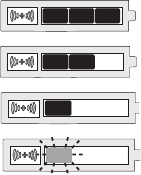
F Consignes relatives aux batteries Li-Ion
42
On obtient ainsi une durée de vie élevée de
la batterie.
– Stockez la batterie si possible au frais
(de 5 °C à 25 °) et au sec (humidité de
l'air < 80%).
– Ne laissez pas par ex. la batterie dans
la voiture en été.
– Une durée d'utilisation nettement rac-
courcie après chaque charge indique
que la batterie est usagée et qu'elle
doit être remplacée.
– Respectez les consignes relatives à
l’élimination.
6.2 L'indicateur de capacité
L'affichage de la capacité
[1-2]
affiche en
appuyant sur la touche Affichage de la ca-
pacité
[1-1]
le niveau de charge de la
batterie :
6.3 Fonctions Bluetooth
Outre l'affichage de la capacité, la batterie
comporte un affichage Bluetooth
[1-3]
qui
affiche l'état de connexion de la batterie :
70 - 100 %
40 - 70 %
15 - 40 %
< à 15 %
Recommandatio
n:
recharger la
batterie avant de
continuer de
l'utiliser.

43
Consignes relatives aux batteries Li-Ion F
La batterie utilise Bluetooth pour
connecter automatiquement des as-
pirateurs équipés en conséquence
en utilisant un outil électroportatif
sans fil.
Liaison de la batterie à l'aspirateur
L'aspirateur peut être relié à un seul
outil électroportatif sans fil à la fois.
Lumière bleue
permanente
L'outil électro-
portatif sans fil
fonctionne et
l'aspirateur est
relié par Blue-
tooth ou la batte-
rie est reliée à un
terminal mobile
Pulsation bleue
La batterie est
prête pour une
connexion au ter-
minal mobile (par
ex. mise à jour
logicielle)
F Consignes relatives aux batteries Li-Ion
44
Si l'aspirateur a été activé avec la
batterie et désactivé avec la com-
mande à distance, une batterie
connectée perd sa connexion tem-
poraire à l'aspirateur. La batterie
peut ensuite être reliée à nouveau.
Activer le mode automatique de l'aspi-
rateur (voir notice d'utilisation de l'as-
pirateur).
Si l'outil électroportatif sans fil était
déjà en service, s'assurer que l'affi-
chage de la capacité de la batterie est
éteint afin que la connexion soit pos-
sible (peut dans certains cas prendre
quelques secondes).
Appuyer une fois sur la touche de
connexion de l'aspirateur ou sur la
commande à distance. <PosNumber/>
La LED du module de réception de
post-équipement clignote lente-
ment avec une lumière rotative
bleue et l'aspirateur est prêt pour la
connexion pour 60 secondes.
Connecter l'outil électroportatif sans
fil.
L'aspirateur se met en marche et la
batterie est connectée jusqu'à la
mise à l'arrêt manuelle de l'aspira-
teur.
Si une deuxième batterie est
connectée à l'aspirateur, la
connexion à la première batterie est
coupée.
45
Consignes relatives aux batteries Li-Ion F
Marche/arrêt de l'aspirateur
Une fois que la connexion entre la batterie
et l'aspirateur est établie, celui-ci dé-
marre automatiquement en utilisant l'ou-
til électroportatif sans fil.
Quand l'aspirateur est désactivé via
la batterie, il continue à fonctionner
quinze secondes.
Appuyer sur l'interrupteur marche/ar-
rêt de l'outil électroportatif sans fil pour
mettre l'aspirateur en marche.
Relâcher l'interrupteur marche/arrêt
de l'outil électroportatif sans fil pour
arrêter l'aspirateur.
Déconnexion de la batterie de l'aspira-
teur
Pour couper la connexion de la batterie et
de l'aspirateur, effectuer l'une des étapes
suivantes :
– Mettre l'aspirateur hors tension
– Placer la batterie sur le chargeur
– Connecter une autre batterie à l'aspi-
rateur
Connexion d'un terminal mobile
La batterie peut être utilisée en relation
avec un terminal mobile (par ex. pour une
mise à jour logicielle avec l'application
Festool).
F Consignes relatives aux batteries Li-Ion
46
Appuyer sur la touche Affichage de la
capacité
[1-1]
jusqu'à ce que l'affichage
Bluetooth
[1-3]
clignote en bleu.
La batterie est prête pour la
connexion pour 60 secondes.
Suivre les instructions dans l'applica-
tion Festool.
7 Entretien et maintenance
Garder les connecteurs de la batterie
propres.
Ne pas couvrir les ouvertures d'aéra-
tion
[1-4]
de la batterie afin de ne pas
limiter le fonctionnement.
Si la batterie ne fonctionne plus, adres-
sez-vous au Service Après-Vente Fes-
tool.
(
www.festool.fr/services
)
8Transport
Les batteries li-Ion sont soumises aux
exigences de la loi allemande sur le
transport des matières dangereuses. Les
batteries li-Ion Festool remplissent les
conditions citées dans le manuel des Na-
tions Unies ST/SG/AC.10/11/Rev.5 partie
III, sous-partie 38.3. L'utilisateur peut
transporter les batteries Festool sans
autre exigence jusqu'au lieu d'utilisation
de la machine, à condition qu'elles soient
protégées contre les court-circuits et
contre tout glissement. Pour l'envoi par
des tiers (par ex. transport aérien ou en-
treprise de transport), tenez compte des
exigences spéciales pour l'emballage et
le marquage. Lors de la préparation pour
l'envoi, une personne instruite en matière
de prescriptions sur les matières dange-

47
Consignes relatives aux batteries Li-Ion F
reuses doit être consultée. Respectez les
autres prescriptions nationales en vi-
gueur.
Expédier le bloc batterie uniquement
lorsque le boîtier n'est pas endommagé.
Recouvrir les contacts ouverts et coincer
le bloc batterie dans l'emballage.
9 Environnement
Remettre les
batteries usagées ou défec-
tueuses
uniquement déchargées et pro-
tégées contre les court-circuits (par ex.
en isolant les pôles avec un ruban adhésif)
aux organismes de recyclage publics (res-
pecter les directives en vigueur).
Les batteries sont ainsi acheminées vers
un recyclage approprié.
Uniquement UE :
d'après la directive eu-
ropéenne relative aux batteries et accu-
mulateurs et sa transposition en droit na-
tional, les batteries/accumulateurs dé-
fectueux ou usagés doivent être collectés
à part et recyclés de manière écologique.
Informations à propos de REACh :
www.festool.com/reach
La marque verbale et les logos "Bluetoo-
th®" sont des marques déposées de la
Bluetooth SIG, Inc. et toute utilisation de
ces marques par la Festool GmbH se fait
sous licence.
Informations relatives à la protection
des données
L'outil électroportatif contient une puce
permettant l'enregistrement automatique
des données de machine et de fonctionne-
F Consignes relatives aux batteries Li-Ion
48
ment. Les données enregistrées ne per-
mettent pas d'effectuer un lien direct avec
les personnes.
Les données peuvent être lues sans
contact à l'aide d'appareils spéciaux.
Elles sont utilisées par Festool unique-
ment pour le diagnostic d'erreurs, la ges-
tion des réparations et de la garantie, ain-
si que pour l'amélioration de la qualité et/
ou le perfectionnement de l'outil électro-
portatif. Toute utilisation des données dé-
passant ce cadre – sans l'accord exprès
du client – est exclue.
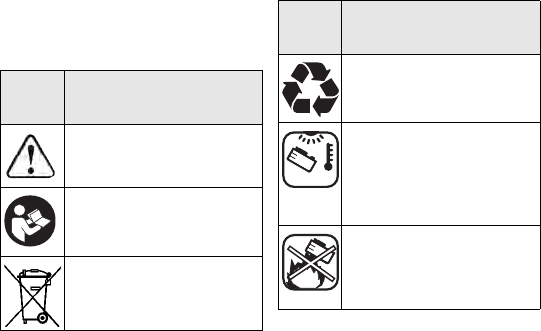
49
Indicaciones para baterías de litio E
Indicaciones para baterías de li-
tio
1Símbolos
Sím-
bolo
Significado
Aviso de peligro general
¡Leer el manual de instruc-
ciones y las indicaciones de
seguridad!
No depositar en la basura
doméstica.
Símbolo de reciclaje: mate-
rial reutilizable
El uso y el almacenamiento
de la batería solo están per-
mitidos en un rango de tem-
peratura comprendido entre -
10 °C y +50 °C.
Proteger la batería del calor y
del fuego y no arrojarla jamás
a las llamas:
¡peligro de
explosión!
Sím-
bolo
Significado
max. 50°C
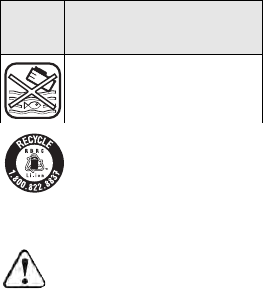
E Indicaciones para baterías de litio
50
2 Indicaciones de seguridad
para baterías de litio
Advertencia. Lea y observe to-
das las indicaciones de seguri-
dad.
Si no se cumplen debida-
mente las indicaciones de seguridad y las
instrucciones, puede producirse una des-
carga eléctrica, quemaduras o lesiones
graves.
Guarde todas las indicaciones de seguri-
dad e instrucciones para que sirvan de
futura referencia.
Las celdas de las baterías de litio están
cerradas herméticamente y son inocuas
siempre y cuando se respeten las especi-
ficaciones del fabricante durante su uso y
manipulación.
–
Manipular con cuidado las baterías
descargadas. Las baterías pueden
constituir una fuente de peligro ya
que pueden provocar corrientes de
cortocircuito muy altas.
No vaciar
completamente las baterías de litio,
incluso aunque parezcan estar des-
Proteger la batería del agua y
no sumergirla en ningún
líquido.
RBRC Sello - LiIon
Sím-
bolo
Significado
51
Indicaciones para baterías de litio E
cargadas.
–
Evitar golpes e influencias físicas.
Las baterías pueden dañarse si reci-
ben un golpe o si se introduce algún
un objeto en ellas.
Esto puede provo-
car fugas, la generación de calor o hu-
mo, o incluso que la batería se inflame
o explote.
–
Mantenga la batería que no utilice
alejada de clips, monedas, llaves,
clavos, tornillos o cualquier otro ob-
jeto metálico pequeño que pueda
provocar el puenteo de los contactos.
Un cortocircuito entre los contactos de
la batería puede causar quemaduras o
fuego
–
No exponer la batería a fuentes de
calor, como por ejemplo, la radiación
solar prolongada o el fuego.
El fuego
y las temperaturas superiores a
130 °C pueden provocar explosiones.
–
No abrir la batería. Los mecanismos
de protección pueden resultar daña-
dos si se abre o modifica la batería.
Esto puede provocar la generación de
calor o humo, o incluso que la batería
se inflame o explote.
–
No sumergir la batería en ningún lí-
quido, como por ejemplo agua (sala-
da) o bebidas. El contacto con
líquidos puede dañar la batería.
Esto
puede provocar la generación de calor
o humo, o incluso que la batería se in-
flame o explote. Dejar de utilizar la
batería y llevarla a un centro autoriza-
do del Servicio de Atención al Cliente
E Indicaciones para baterías de litio
52
de Festool.
–
Las baterías deben cargarse exclusi-
vamente en cargadores recomenda-
dos por el fabricante (ver figura).
Existe riesgo de incendio si un carga-
dor apto para un determinado tipo de
batería se utiliza con otras baterías.
–
No utilizar agua para apagar una ba-
tería de litio en llamas, utilizar siem-
pre arena
o una manta contra
incendios.
–
En caso de daño o uso inadecuado de
la batería, pueden desprenderse va-
pores.
Los vapores pueden irritar las
vías respiratorias. Tome aire fresco y
consulte a un médico si siente moles-
tias.
–
Utilice la batería únicamente con su
herramienta eléctrica Festool.
Solo
de esta manera la batería queda pro-
tegida contra sobrecargas peligrosas.
El uso de otra herramienta puede pro-
vocar lesiones y riesgo de incendio.
–
Si la batería se utiliza incorrecta-
mente, pueden producirse fugas de
líquido. Evite el contacto con este lí-
quido. En caso de contacto acciden-
tal, enjuague con agua. Si el líquido
entra en contacto con los ojos, bus-
que además asistencia médica.
El lí-
quido derramado de la batería puede
causar irritaciones en la piel o quema-
duras.
–
Si la batería está defectuosa, pueden
derramarse líquidos que pueden ca-
lar los objetos adyacentes.
Comprue-
be las piezas afectadas y límpielas

53
Indicaciones para baterías de litio E
absorbiendo el líquido con papel de
cocina seco y enjuagándolas con
abundante agua. Evite el contacto con
la piel llevando guantes de protección.
Dado el caso, sustituya las piezas.
–
No utilizar baterías dañadas o modi-
ficadas.
Las baterías dañadas o modi-
ficadas pueden presentar
características no previsibles que
pueden derivar en fuego, explosión o
lesiones.
–
No abrir, aplastar, sobrecalentar (a
más de 80 °C) ni quemar la batería.
Si
no se tiene en cuenta esta advertencia
existe riesgo de quemaduras e incen-
dio. Siga las indicaciones del fabrican-
te.
–
No utilizar baterías dañadas. La ba-
tería debe dejar de utilizarse de in-
mediato en cuanto se aprecien
características anormales, por ejem-
plo, si desprende olor o calor, o si
presenta decoloración o deforma-
ción.
Si se sigue utilizando, la batería
puede generar calor e humo, infla-
marse o explotar.
3Datos técnicos
Batería BP 18 Li
Frecuencia 2402 Mhz – 2480 Mhz
Potencia iso-
trópica radiada
equivalente
(PIRE)
<10 dBm

E Indicaciones para baterías de litio
54
Consultar la placa de características para
más datos técnicos de la batería.
4 Uso conforme a lo previsto
Las baterías son aptas para su uso con
herramientas eléctricas Festool y los car-
gadores Festool indicados (ver figura).
La batería es compatible con la conexión/
desconexión automática del sistema mó-
vil de aspiración.
5Componentes
Las figuras* indicadas se encuentran al
principio del manual de instrucciones.
* Las figuras pueden diferir del original.
6Operativa
[1-1]
Tecla de indicación de la capaci-
dad
[1-2]
Indicación de capacidad
[1-3]
Indicación de Bluetooth
[1-4]
Orificios de ventilación (solo BP 18
Li ... ASI)
[1-5]
Teclas para soltar el acumulador
ATENCIÓN
Peligro de lesiones: encendido ine-
sperado del sistema móvil de aspira-
ción
Antes de operar con el sistema móvil
de aspiración, comprobar qué batería
está conectada al mismo.

55
Indicaciones para baterías de litio E
6.1 Indicaciones para optimizar el ma-
nejo de la batería
La batería se suministra a media
carga. A fin de garantizar el máximo
rendimiento de la batería, cargar to-
talmente la batería en el cargador
antes del primer uso.
La batería puede cargarse en cualquier
momento sin que ello acorte su vida útil.
Interrumpir el proceso de carga no daña
la batería.
Una vez la herramienta se ha
desconectado automática-
mente, no volver a pulsar el in-
terruptor de conexión y desco-
nexión.
La batería puede sufrir
daños.
La batería está equipada con un control de
temperatura que permite la recarga úni-
camente dentro de un rango de tempera-
tura situado entre 0 °C y 50 °C. De esta
manera se alarga su vida útil.
– Guardar la batería en un lugar fresco
(entre 5 °C y 25 °C) y seco (humedad
del aire < 80 %).
– No dejar la batería en el vehículo en
verano.
– Una reducción significativa de la dura-
ción del funcionamiento indica que la
batería está gastada y que debe susti-
tuirse.
– Observar las indicaciones para la eli-
minación.
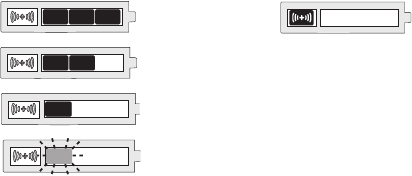
E Indicaciones para baterías de litio
56
6.2 Indicación de capacidad
Al pulsar la tecla de indicación de la capa-
cidad
[1-1]
, el indicador de capacidad
[1-
2]
muestra el estado de carga de la bate-
ría:
6.3 Funciones Bluetooth
Junto al indicador de capacidad se en-
cuentra el indicador de Bluetooth
[1-3]
,
que muestra el estado de conexión de la
batería:
70-100 %
40-70 %
15-40 %
<15%
Recomendación:
cargar la batería
antes de cada
nueva utilización.
Azul permanente
La herramienta
eléctrica de bate-
ría está en fun-
cionamiento y el
sistema móvil de
aspiración está
conectado por
Bluetooth, o la
batería está
conectada con un
terminal móvil

57
Indicaciones para baterías de litio E
La batería utiliza Bluetooth para co-
nectar automáticamente el sistema
móvil de aspiración (adecuadamen-
te equipado) al utilizarlo con una he-
rramienta eléctrica de batería.
Conectar la batería con el sistema móvil
de aspiración
El sistema móvil de aspiración solo
se puede conectar con una única he-
rramienta eléctrica de batería en
casa uso.
Cuando el sistema móvil de aspira-
ción se conecta primero con la bate-
ría y después se desconecta con el
mando a distancia, la batería conec-
tada pierde temporalmente la cone-
xión con el sistema móvil de aspira-
ción. La batería puede conectarse de
nuevo posteriormente.
Activar el modo automático del sistema
móvil de aspiración (véase el manual de
instrucciones correspondiente).
Si la herramienta eléctrica de batería ya
se ha utilizado previamente, comprobar
que el indicador de capacidad de la ba-
tería esté apagado para que sea posible
Azul intermi-
tente
La batería está
lista para conec-
tarse con el ter-
minal móvil (p. ej.
actualización de
software)
E Indicaciones para baterías de litio
58
realizar la conexión (puede tardar algu-
nos segundos en casos determinados).
Pulsar una vez la tecla de conexión en
el sistema móvil de aspiración o en el
mando a distancia. <PosNumber/>
El LED del módulo de recepción de
reequipamiento parpadea y gira len-
tamente, en color azul, y el sistema
móvil de aspiración queda listo para
conectarse durante 60 segundos.
Conectar la herramienta eléctrica de
batería.
El sistema móvil de aspiración se
pone en marcha, y la batería queda
conectada hasta la desconexión ma-
nual del sistema.
Si se conecta una segunda batería
con el sistema móvil de aspiración,
se interrumpe la conexión de la pri-
mera.
Conexión y desconexión del sistema mó-
vil de aspiración
Tras establecer la conexión entre la bate-
ría y el sistema móvil de aspiración, este
se pone en marcha automáticamente si se
utiliza una herramienta eléctrica de bate-
ría.
Si el sistema móvil de aspiración se
apaga mediante la batería, este se-
guirá funcionando durante 15 se-
gundos más.
Pulsar el interruptor de conexión y des-
conexión de la herramienta eléctrica de
batería para conectar el sistema móvil
de aspiración.
59
Indicaciones para baterías de litio E
Soltar el interruptor de conexión y des-
conexión de la herramienta eléctrica de
batería para desconectar el sistema
móvil de aspiración.
Desconectar la batería del sistema móvil
de aspiración
Para interrumpir la conexión de la batería
y el sistema móvil de aspiración proceda
mediante una de las opciones siguientes:
– Desconectar el sistema móvil de aspi-
ración de la corriente
– Colocar la batería sobre el cargador
– Conectar otra batería al sistema móvil
de aspiración
Conexión de un terminal móvil
La batería puede utilizarse junto con un
terminal móvil (p. ej. para una actualiza-
ción de software con la aplicación de Fes-
tool).
Pulsar la tecla de indicación de la capa-
cidad
[1-1]
hasta que el indicador de
Bluetooth
[1-3]
parpadee en color azul.
La batería queda lista para conec-
tarse durante 60 segundos.
Seguir las indicaciones de la aplicación
de Festool.
7 Mantenimiento y cuidado
Mantener limpios los contactos de co-
nexión de la batería.
Mantener abiertos los orificios de venti-
lación
[1-4]
de la batería a fin de no li-
mitar su funcionamiento.
Cuando la batería deje de estar operati-
va, llevarla a un centro autorizado del
Servicio de Atención al Cliente de Fes-
E Indicaciones para baterías de litio
60
tool.
(
www.festool.es/servicios
)
8Transporte
Las baterías de iones de litio incluidas es-
tán sujetas a las disposiciones de la legis-
lación sobre transporte de mercancías
peligrosas. Las baterías de iones de litio
Festool cumplen los requisitos conforme
al Manual de pruebas y criterios de la
ONU ST/SG/AC.10/11/Rev.5 parte III, sub-
sección 38.3. El usuario puede transpor-
tar por carretera baterías Festool sin so-
portes adicionales hasta el lugar de uso
de la herramienta, siempre que estén
protegidas frente a cortocircuitos y ase-
guradas contra resbalamiento. Para el
transporte mediante servicios de terceros
(p. ej., transporte aéreo o empresa de
transportes) es obligatorio cumplir unos
requisitos particulares en cuanto a emba-
laje y señalización. Debe consultarse a
una persona instruida en las disposicio-
nes sobre mercancías peligrosas para la
preparación del envío. Ténganse en cuen-
ta el resto de regulaciones nacionales.
Enviar la batería solo si la carcasa no está
dañada. Cubrir con cinta adhesiva los
contactos abiertos y guardar la batería de
modo que no se pueda mover dentro del
embalaje.
9 Medio ambiente
Las baterías desgastadas o estropeadas
deben descargarse, asegurarse para evi-
tar cortocircuitos (p. ej., aislando los polos
con cinta aislante) y llevarse a un punto de

61
Indicaciones para baterías de litio E
recogida (se han de tener en cuenta las
regulaciones vigentes).
Las baterías deben reciclarse según la
normativa vigente.
Solo UE:
de acuerdo con la directiva euro-
pea sobre baterías y acumuladores y su
transposición a la legislación nacional,
las baterías/acumuladores defectuosos o
usados deben recogerse por separado y
reciclarse de forma respetuosa con el
medio ambiente.
Información sobre REACh:
www.festool.com/reach
La marca denominativa y el logotipo de
Bluetooth® son marcas registradas de
Bluetooth SIG, Inc. Por lo tanto, todo uso
que Festool GmbH haga de dicha marca
está sujeto a un contrato de licencia.
Información relativa a la protección de
datos
La herramienta eléctrica contiene un chip
que almacena automáticamente los datos
de servicio y de la máquina. Los datos
guardados no pueden estar directamente
relacionados con ninguna persona.
Los datos pueden leerse sin contacto con
dispositivos especiales, y Festool los utili-
za exclusivamente para el diagnóstico de
fallos, la gestión de las reparaciones y de
la garantía, así como para la mejora de la
calidad o el perfeccionamiento de la he-
rramienta eléctrica. Los datos no se utili-
zan para otros fines sin el consentimiento
expreso del cliente.
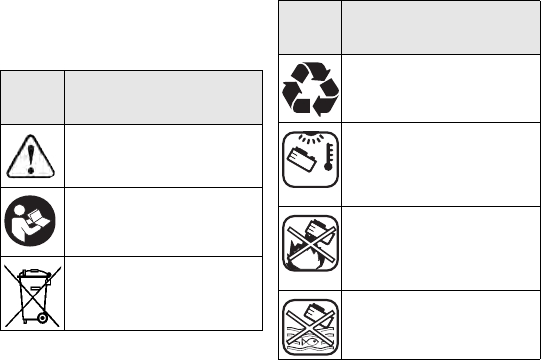
I Avvertenze per le batterie agli ioni di litio
62
Avvertenze per le batterie agli
ioni di litio
1Simboli
Sim-
bolo
Significato
Avvertenza di pericolo gene-
rico
Leggere le istruzioni d'uso e
le avvertenze di sicurezza.
Non smaltire tra i rifiuti
domestici.
Simbolo Recycling - Mate-
riale riutilizzabile
Utilizzo e stoccaggio della
batteria solo nel range di
temperatura da -10 °C a max.
+50 °C.
Proteggere da calore e da
fiamme aperte - non gettare
la batteria sul fuoco –
Peri-
colo di esplosione!
Proteggere dall'acqua - non
immergere in liquidi.
Sim-
bolo
Significato
max. 50°C
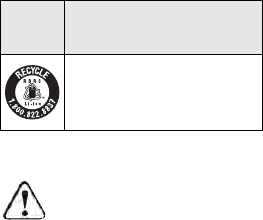
63
Avvertenze per le batterie agli ioni di litio I
2 Avvertenze per la sicurezza
per batterie agli ioni di litio
Attenzione! Leggere tutte le av-
vertenze per la sicurezza e le
indicazioni.
Eventuali errori
nell'osservanza delle avvertenze di sicu-
rezza e delle istruzioni d'uso possono pro-
vocare scosse elettriche, incendi e/o gravi
lesioni.
Conservate tutte le avvertenze di sicu-
rezza e le istruzioni d'uso per riferimenti
futuri.
Le celle agli ioni di litio sono chiuse a te-
nuta di gas e non provocano effetti nocivi
se nell'uso e nella manipolazione sono ri-
spettate le disposizioni del costruttore.
–
Maneggiare con cura le batterie sca-
riche. Le batterie rappresentano una
fonte di pericolo, in quanto possono
causare una corrente di cortocircuito
molto elevata.
Anche se le batterie
agli ioni di litio si trovano apparente-
mente in condizione scarica, in realtà
non sono mai completamente scari-
che.
–
Evitare colpi/impatti fisici. I colpi e la
penetrazione di oggetti possono dan-
Sigillo RBRC - Li-Ion
Sim-
bolo
Significato
I Avvertenze per le batterie agli ioni di litio
64
neggiare la batteria,
causando perdi-
te, sviluppo di calore, di fumo,
infiammazione o l'esplosione della
batteria.
–
Tenere la batteria non utilizzata lon-
tano da clip, monete, chiavi, chiodi,
viti o altri piccoli oggetti metallici che
potrebbero provocare un bypass dei
contatti.
Un cortocircuito tra i contatti
della batteria può provocare ustioni o
incendi
–
Proteggere il pacco batterie dal calo-
re, dall'irraggiamento solare conti-
nuato e dal fuoco!
Il fuoco e le
temperature superiori a 130° C posso-
no causare esplosioni.
–
Non aprire la batteria. L'apertura o la
modifica della batteria può danneg-
giare le misure protettive,
causando
sviluppo di calore, di fumo, infiamma-
zione o l'esplosione della batteria.
–
Non immergere la batteria in liquidi
quali acqua (salina) o bevande. Il con-
tatto con liquidi può danneggiare la
batteria,
causando sviluppo di calore,
di fumo, infiammazione o l'esplosione
della batteria. Non continuare ad uti-
lizzare la batteria e rivolgersi a un ser-
vizio assistenza Festool autorizzato.
–
Caricare le batterie solo in caricabat-
terie raccomandati dal produttore
(vedere immagine).
Nel caso di un ca-
ricabatterie idoneo per un determina-
to tipo di batterie, sussiste pericolo
d'incendio qualora venga utilizzato
65
Avvertenze per le batterie agli ioni di litio I
con altre batterie.
–
Non utilizzare acqua per estinguere
un eventuale incendio delle batterie
Li-Ion!
Utilizzare invece della sabbia o
una coperta ignifuga.
–
In caso di danneggiamento e uso non
corretto della batteria possono fuori-
uscire vapori.
I vapori possono irritare
le vie aeree. Far circolare aria fresca e,
in caso di disturbi,rivolgersi a un me-
dico.
–
Utilizzare la batteria solo in abbina-
mento al proprio utensile elettrico
Festool.
Solo in tal modo la batteria
viene protetta da pericoloso sovracca-
rico. L'impiego di un altro attrezzo può
provocare lesioni e percolo d'incendio.
–
In caso di utilizzo errato, dalla batte-
ria può fuoriuscire del liquido. Evita-
re di entrare a contatto con
quest'ultimo. In caso di contatto acci-
dentale, lavare con acqua. Se il liqui-
do entra negli occhi, consultare un
medico.
Il liquido che fuoriesce dalla
batteria può provocare irritazioni cu-
tanee o ustioni.
–
Se la batteria è difettosa, può fuoriu-
scire liquido e bagnare gli oggetti
adiacenti.
Controllare i pezzi coinvolti.
Pulirli, assorbendo il liquido con tova-
gliolo di carta asciutto e risciacquare
abbondantemente con acqua. Evitare
il contatto con la pelle indossando
guanti di protezione. All'occorrenza,
sostituire i pezzi.
–
Non utilizzare batterie danneggiate o
modificate.
Le batterie danneggiate o

I Avvertenze per le batterie agli ioni di litio
66
modificate possono avere caratteristi-
che imprevedibili, che possono provo-
care incendi, esplosione o lesioni.
–
Non aprire, comprimere, surriscal-
dare (oltre 80°C) la batteria, né in-
cendiarla.
Diversamente si incorre nel
pericolo di ustioni e incendio. Seguire
le istruzioni del costruttore.
–
Non utilizzare batterie danneggiate.
L'utilizzo di una batteria deve essere
interrotto immediatamente se si ri-
scontrano caratteristiche anomale,
quali sviluppo di fumo, calore, colo-
razione o deformazione.
Se si conti-
nua l'utilizzo, la batteria può
sviluppare calore e fumo, accendersi o
esplodere.
3 Dati tecnici
Per ulteriori dati tecnici consultare la tar-
ghetta dati sulla batteria.
4 Utilizzo conforme
Le batterie sono idonee per l'impiego con
utensili elettrici a batteria Festool e i cari-
cabatterie Festool indicati (vedere imma-
gine).
Batteria BP 18 Li
Frequenza 2402 Mhz – 2480 Mhz
Potenza isotro-
pica irradiata
equivalente
(EIRP)
<10 dBm

67
Avvertenze per le batterie agli ioni di litio I
La batteria è idonea per l'accensione/spe-
gnimento automatici dell'unità mobile
d'aspirazione.
5 Elementi dell'utensile
Le illustrazioni* indicate si trovano nella
parte iniziale delle istruzioni per l'uso.
* Le immagini possono differire dall'origi-
nale.
6Funzionamento
6.1 Avvertenze sul corretto utilizzo
della batteria
La batteria è fornita parzialmente
carica. Per garantire la piena pre-
stazione della batteria, prima
dell'utilizzo ricaricarla completa-
mente nel caricabatterie.
[1-1]
Tasto indicatore di capacità
[1-2]
Indicatore della capacità
[1-3]
Indicatore Bluetooth
[1-4]
Aperture di ventilazione (solo BP
18 Li ... ASI)
[1-5]
Tasti per rimuovere le batterie
ATTENZIONE
Pericolo di lesioni, avvio inatteso
dell'unità mobile d'aspirazione
Prima di qualsiasi lavoro con l'unità
mobile d'aspirazione controllare quale
batteria è collegata con essa.
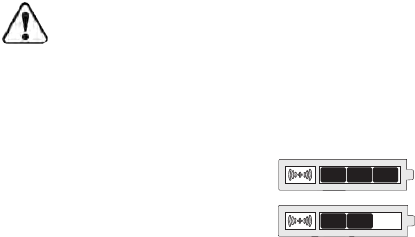
I Avvertenze per le batterie agli ioni di litio
68
La batteria può essere caricata in qualsi-
asi momento, senza che la sua durata
venga ridotta. Un'interruzione della pro-
cedura di carica non danneggia la batte-
ria.
Dopo lo spegnimento automa-
tico dell'utensile elettrico, non
tenere premuto l'interruttore
on/off.
La batteria può venire
danneggiata.
La batteria è dotata di un con-
trollo della temperatura che ne consente
la carica soltanto nell'intervallo di tempe-
ratura compreso tra 0 °C e 50 °C. In tal
modo si ottiene una durata elevata della
batteria.
– Conservare la batteria in un luogo fre-
sco (5 °C - 25 °C) e secco (umidità <
80%).
– In estate, non lasciare la batteria in
macchina.
– Un tempo di esercizio decisamente ri-
dotto per ricarica indica che la batteria
è esausta e deve essere sostituita.
– Osservare le Indicazioni per lo smalti-
mento.
6.2 Indicatore della capacità
Quando si preme il tasto indicatore di ca-
pacità
[1-1]
l'indicatore di capacità
[1-2]
indica lo stato di carica della batteria:
70 - 100%
40 - 70%

69
Avvertenze per le batterie agli ioni di litio I
6.3 Funzioni Bluetooth
Accanto all'indicatore di capacità si trova
l'indicatore Bluetooth
[1-3]
, che indica lo
stato di collegamento della batteria:
15 - 40%
< 15%
Raccomanda-
zione:
caricare la
batteria prima di
continuare a uti-
lizzarla.
Luce fissa blu
Utensile elettrico
a batteria in fun-
zione e unità
mobile d'aspira-
zione collegata
via Bluetooth
oppure batteria
collegata con un
dispositivo porta-
tile

I Avvertenze per le batterie agli ioni di litio
70
La batteria utilizza il Bluetooth per
accendere automaticamente unità
mobili d'aspirazione opportuna-
mente equipaggiate per l'impiego
con un utensile elettrico a batteria.
Collegamento della batteria con l'unità
mobile d'aspirazione
L'unità mobile d'aspirazione può es-
sere collegata contemporaneamen-
te con un solo utensile elettrico a
batteria.
Se l'unità mobile d'aspirazione è
stata accesa inizialmente con la bat-
teria e viene spenta con il comando a
distanza, la batteria perde il suo col-
legamento temporaneo con l'unità
mobile d'aspirazione. Poi la batteria
può essere collegata di nuovo.
Attivare il modo automatico dell'unità
mobile d'aspirazione (vedere le istru-
zioni per l'uso dell'unità mobile d'aspi-
razione).
Se l'utensile elettrico a batteria era già
in funzione, accertarsi che l'indicatore
di capacità della batteria sia spento, af-
finché il collegamento sia possibile (in
Blu intermittente
La batteria è
pronta per un
collegamento con
il dispositivo por-
tatile (p. es.
update software)
71
Avvertenze per le batterie agli ioni di litio I
qualche caso può richiedere alcuni se-
condi).
Premere una volta il tasto di collega-
mento sull'unità mobile d'aspirazione o
sul comando a distanza. <PosNumber/>
Il LED sul modulo ricevitore aggiun-
tivo lampeggia in blu ruotando len-
tamente e l'unità mobile d'aspira-
zione è pronta per il collegamento
per 60 secondi.
Accendere l'utensile elettrico a batte-
ria.
L'unità mobile d'aspirazione si avvia
e la batteria è collegata fino allo
spegnimento manuale dell'unità.
Se si collega all'unità mobile d'aspi-
razione una seconda batteria, la pri-
ma batteria viene scollegata
dall'unità.
Accensione/spegnimento dell'unità mo-
bile d'aspirazione
Dopo che è stabilito il collegamento della
batteria e dell'unità mobile d'aspirazione,
l'unità si avvia automaticamente quando
l'utensile elettrico a batteria viene usato.
Se l'unità mobile d'aspirazione viene
spenta tramite la batteria, continua
a funzionare per quindici secondi.
Premere l'interruttore ON/OFF
dell'utensile elettrico a batteria per ac-
cendere l'unità mobile d'aspirazione.
Rilasciare l'interruttore ON/OFF
dell'utensile elettrico a batteria per
spegnere l'unità mobile d'aspirazione.
I Avvertenze per le batterie agli ioni di litio
72
Scollegamento della batteria dall'unità
mobile d'aspirazione
Per staccare il collegamento tra la batte-
ria e l'unità mobile d'aspirazione, esegui-
re uno dei seguenti passi:
– Staccare l'alimentazione elettrica
dell'unità mobile d'aspirazione
– Collocare la batteria sul caricabatterie
– Collegare un'altra batteria con l'unità
mobile d'aspirazione
Collegamento di un dispositivo portatile
La batteria può essere utilizzata in colle-
gamento con un dispositivo portatile (p.
es. per un update software con l'app Fe-
stool).
Premere il tasto indicatore di capacità
[1-1]
fino a quando l'indicatore Blueto-
oth
[1-3]
non lampeggia in blu.
La batteria è pronta al collegamento
per 60 secondi.
Seguire le istruzioni dell'app Festool.
7 Manutenzione e cura
Tenere puliti i contatti di collegamento
sulla batteria.
Tenere aperte le aperture di areazione
[1-4]
sulla batteria, diversamente si ha
una limitazione della funzione.
Quando la batteria non è più funzionan-
te, rivolgersi a un servizio clienti Festo-
ol autorizzato.
(
www.festool.com/service
)
73
Avvertenze per le batterie agli ioni di litio I
8Trasporto
Le batterie agli ioni di litio in dotazione
sono soggette ai requisiti di legge in meri-
to al trasporto di merci pericolose. Le bat-
terie agli ioni di litio Festool soddisfano
tali condizioni secondo il manuale UN ST/
SG/AC.10/11/Rev.5 parte III, paragrafo
38.3. L'utente può trasportare con sé le
batterie Festool fino al sito di impiego
senza ulteriori obblighi, a condizione che
siano protette per evitarne cortocircuiti e
scivolamenti. In caso di spedizione da
parte di terzi (ad es. mediante spedizio-
niere o trasporto aereo) è indispensabile
prestare attenzione ai requisiti di imbal-
laggio e di contrassegno richiesti dalla le-
gislazione in materia. Nella preparazione
del pezzo da spedire si deve coinvolgere
una persona istruita nella movimentazio-
ne di merci pericolose. Osservare anche
altre eventuali disposizioni di legge nazio-
nali in merito.
Spedire solo batterie il cui involucro non
presenti danneggiamenti. Coprire i con-
tatti liberi e disporre la batteria nell'im-
ballaggio in modo che non possa spostar-
si al suo interno.
9Ambiente
In caso di batterie usate o difettose
limi-
tarsi a scaricarle e restituirle ai punti di
raccolta dopo averle protette da cortocir-
cuito (es. isolando i poli con nastro adesi-
vo) (osservare le disposizioni in vigore).
I pacchi batteria verranno immessi nel ci-
clo di recupero controllato.
Solo UE:
in base alla direttiva europea su
batterie e accumulatori e la sua applica-

I Avvertenze per le batterie agli ioni di litio
74
zione in ambito nazionale, le batterie
esauste o guaste devono essere raccolte
separatamente e immesse nel circolo di
recupero ecocompatibile.
Informazioni su REACh:
www.festool.com/reach
Il marchio denominativo Bluetooth® ed i
loghi sono marchi registrati della Blueto-
oth SIG, Inc. ed ogni utilizzo di questi mar-
chi da parte di Festool GmbH è vincolato
da licenza.
Informazioni sulla protezione dei dati
L'elettroutensile contiene un chip per il
salvataggio automatico dei dati della mac-
china e di funzionamento. I dati salvati non
contengono riferimenti personali diretti.
I dati possono essere letti con strumenti
speciali senza contatto e vengono utilizza-
ti da Festool esclusivamente per la dia-
gnostica errori, per avvalersi della garan-
zia e a scopo di riparazione, nonché per il
miglioramento della qualità e/o l'ulteriore
sviluppo dell'elettroutensile. Non è previ-
sto un utilizzo diverso dei dati, senza pre-
via autorizzazione esplicita del cliente.
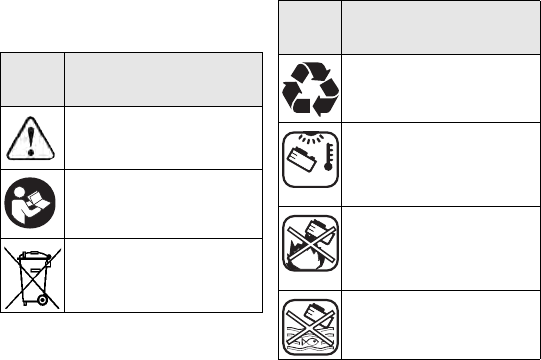
75
Instructies voor Li-ion accupacks NL
Instructies voor Li-ion accupacks
1Symbolen
Sym-
bool
Betekenis
Waarschuwing voor alge-
meen gevaar
Lees de gebruiksaanwijzing
en veiligheidsvoorschriften!
Niet met het huisvuil meege-
ven.
Recyclingsymbool - her-
bruikbaar materiaal
Gebruik en opslag van de
accu alleen in het tempera-
tuurbereik van - 10 °C tot + 50
°C.
Niet aan hitte of open vuur
blootstellen – nooit in het
vuur gooien –
explosiege-
vaar!
Tegen water beschermen –
niet in vloeistoffen dompelen.
Sym-
bool
Betekenis
max. 50°C
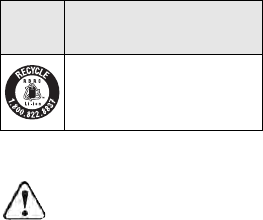
NL Instructies voor Li-ion accupacks
76
2 Veiligheidsinstructies voor
Li-ion-accupacks
Waarschuwing! Lees alle vei-
ligheidsvoorschriften en aan-
wijzingen.
Worden de veilig-
heidsinstructies en aanwijzingen niet in
acht genomen, dan kan dit een elektri-
sche schok, brand en/of ernstig letsel tot
gevolg hebben.
Bewaar alle veiligheidsinstructies en
handleidingen om ze later te kunnen
raadplegen.
Cellen in Lithium-ion-accupacks zijn gas-
dicht afgesloten en onschadelijk zover bij
het gebruik en het onderhoud de voor-
schriften van de fabrikant in acht geno-
men worden.
–
Ontladen accu's voorzichtig behan-
delen. Accupacks vormen een risico
omdat ze een zeer hoge kortsluit-
stroom kunnen veroorzaken.
Zelfs
als Lithium-ion-accupacks schijnbaar
in ontladen staat zijn, ontladen deze
zich nooit volledig.
–
Fysieke stoten/beïnvloeding vermij-
den. Stoten en binnendringen van
voorwerpen kunnen de accu's be-
RBRC-stempel - Li-ion
Sym-
bool
Betekenis
77
Instructies voor Li-ion accupacks NL
schadigen.
Dit kan tot lekkages, hitte-
ontwikkeling, rookontwikkeling,
ontbranding of explosie van het ac-
cupack leiden.
–
Houd het niet-gebruikte accupack
verwijderd van paperclips, munten,
sleutels, spijker, schroeven of andere
kleine metalen voorwerpen die een
overbrugging van de contacten kun-
nen veroorzaken.
Een kortsluiting
tussen de accucontacten kan tot ver-
brandingen of vuur leiden.
–
Accupack niet aan hitte, zoals voort-
durend zonlicht of vuur, blootstellen.
Vuur en temperaturen van meer dan
130°C kunnen een explosie veroorza-
ken.
–
Open het accupack niet. Door het ac-
cupack te openen of te wijzigen kun-
nen de veiligheidsvoorzieningen
beschadigd raken.
Dit kan tot hitte-
ontwikkeling, rookontwikkeling, ont-
steking of explosie van het accupack
leiden.
–
Accupack niet in vloeistoffen zoals
(zout) water of dranken dompelen.
Contact met vloeistoffen kan het ac-
cupack beschadigen.
Dit kan tot hitte-
ontwikkeling, rookontwikkeling,
ontsteking of explosie van het ac-
cupack leiden. Het accupack niet
meer gebruiken en contact opnemen
met de klantenservice van Festool.
–
Laad de accupacks alleen op in op-
laadapparaten die door de fabrikant
worden aanbevolen (zie afbeelding).
Voor een oplaadapparaat dat voor een
NL Instructies voor Li-ion accupacks
78
bepaalde soort accupack geschikt is,
bestaat brandgevaar als het met an-
dere accupacks wordt gebruikt.
–
Brandende Li-ion-accupacks nooit
met water blussen, zand
of brandde-
ken gebruiken.
–
Bij beschadiging en ondeskundig ge-
bruik van het accupack kunnen dam-
pen vrijkomen.
De dampen kunnen de
luchtwegen irriteren.Ventileer de
ruimte en consulteer bij klachten een
arts.
–
Gebruik het accupack alleen in com-
binatie met elektrisch gereedschap
van Festool.
Alleen op die manier
wordt het accupack tegen gevaarlijke
overbelasting beschermd. Het ge-
bruik van ander gereedschap kan lei-
den tot lichamelijk letsel en
brandgevaar.
–
Bij verkeerd gebruik kan zuur uit het
accupack vrijkomen. Vermeid het
contact daarmee. Indien u onver-
hoopt in aanraking komt met het
zuur, moet u met overvloedig water
afspoelen. Als het zuur in de ogen
komt, moet u direct een arts opzoe-
ken.
Vrijkomend accuzuur kan tot hui-
dirritaties of verbrandingen leiden.
–
Bij een defect accupack kan zuur vrij-
komen en omliggende voorwerpen
beschadigen
.Controleer de betroffen
onderdelen. Reinig deze door de vloei-
stof met droog keukenpapier op te zui-
gen en met veel water na te spoelen.
Vermijd huidcontact door veiligheids-
handschoenen te dragen. Vervang

79
Instructies voor Li-ion accupacks NL
eventueel de onderdelen.
–
Beschadigde of gewijzigde accupacks
niet gebruiken.
Beschadigde of gewij-
zigde accupacks kunnen onvoorziene
eigenschappen ontwikkelen die tot
brand, explosie of persoonlijk letsel
kunnen leiden.
–
Het accupack niet openen, indruk-
ken, oververhitten (meer dan 80°C)
of verbranden.
Bij niet-opvolging be-
staat verbrandings- en brandgevaar.
Volg de instructies van de fabrikant.
–
Beschadigde accupacks niet gebrui-
ken. Het gebruik van een accupack
moet onmiddellijk gestopt worden
zodra deze abnormale eigenschap-
pen vertoont zoals geurontwikkeling,
hitte, verkleuring of vervorming.
Bij
voortgezet gebruik kan het accupack
hitte en rook ontwikkelen, ontbranden
of exploderen.
3 Technische gegevens
Meer technische gegevens, zie typeplaat-
je op het accupack.
Accupack BP 18 Li
Frequentie 2402 Mhz – 2480 Mhz
Equivalent isot-
roop uitge-
straald
vermogen
(EIRP)
<10 dBm

NL Instructies voor Li-ion accupacks
80
4 Gebruik volgens de voor-
schriften
Accupacks zijn geschikt voor gebruik met
Festool-accugereedschappen en gespeci-
ficeerde Festool-oplaadapparaten (zie af-
beelding).
Het accupack is geschikt voor het auto-
matisch in- /uitschakelen van de mobiele
stofzuiger.
5 Toestelelementen
De vermelde afbeeldingen* staan in het
begin van de gebruiksaanwijzing.
* Afbeeldingen kunnen van het origineel
afwijken.
6Gebruik
[1-1]
Toets capaciteitsindicatie
[1-2]
Vermogensindicatie
[1-3]
Bluetooth-indicatie
[1-4]
Ventilatieopeningen (alleen BP 18
Li ... ASI)
[1-5]
Toetsen voor het losmaken van
het accupack
VOORZICHTIG
Letselgevaar, onverwachte aanloop
mobiele stofzuiger
Voor alle werkzaamheden met de mo-
biele stofzuiger controleren welk ac-
cupack met de mobiele stofzuiger is
verbonden.

81
Instructies voor Li-ion accupacks NL
6.1 Tips voor de juist omgang met het
accupack
Het accupack wordt gedeeltelijk ge-
laden geleverd. Om het volle vermo-
gen van het accupack te garanderen,
dient u het vóór het eerste gebruik
geheel op te laden.
Het accupack kan altijd opgeladen wor-
den zonder de levensduur te verkorten.
Een onderbreking van het opladen be-
schadigt het accupack niet.
Na de automatische uitschake-
ling van het elektrisch gereed-
schap niet verder op de aan-/
uitschakelaar drukken.
Het
accupack kan beschadigd wor-
den.
Het accupack is met een temperatuurbe-
waking uitgerust die alleen een oplading
in het temperatuurbereik tussen 0 °C en
50 °C toelaat. Hierdoor wordt een hoge
acculevensduur bereikt.
– Accupack zo koel mogelijk (5 °C tot
25 °C) en droog (luchtvochtigheid <
80%) opslaan.
– Accupack bijv. in de zomer niet in de
auto laten liggen.
– Een aanzienlijk kortere bedrijfsduur
na de oplading geeft aan dat het ac-
cupack verbruikt is en vervangen dient
te worden.
– Instructies voor verwijdering.
6.2 Capaciteitsindicatie
De capaciteitsindicatie
[1-2]
geeft bij in-
drukken van de toets voor de capaci-
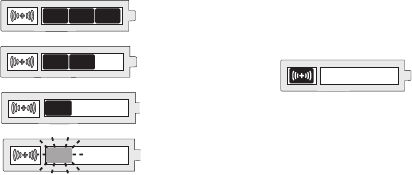
NL Instructies voor Li-ion accupacks
82
teitsindicatie
[1-1]
de laadtoestand van
het accupack weer:
6.3 Bluetooth-functies
Naast de capaciteitsindicatie bevindt zich
de Bluetooth-indicatie
[1-3]
die de ver-
bindingsstatus van het accupack weer-
geeft:
70 - 100 %
40 - 70 %
15 - 40 %
< 15 %
Advies:
Laad het
accupack op
alvorens de
machine verder
te gebruiken.
Blauw continu
licht
Accugereed-
schap loopt en
mobiele stofzui-
ger is via Blue-
tooth verbonden
of het accupack is
met een mobiel
eindapparaat
verbonden

83
Instructies voor Li-ion accupacks NL
Het accupack gebruikt Bluetooth om
passend uitgeruste mobiele stofzui-
gers bij het gebruik met een accuge-
reedschap automatisch te schake-
len.
Accupack met mobiele stofzuiger verbin-
den
De mobiele stofzuiger kan gelijktij-
dig met slechts één accugereed-
schap worden verbonden.
Als de mobiele stofzuiger initieel
met het accupack werd ingescha-
keld en met de afstandsbediening
uitgeschakeld wordt, verliest een
verbonden accupack zijn tijdelijke
verbinding met de mobiele stofzui-
ger. Vervolgens kan het accupack
beschadigd worden.
De automaatmodus van de mobiele
stofzuiger activeren (zie bedienings-
handleiding van de mobiele stofzuiger).
Als het accugereedschap al in gebruik
was, ervoor zorgen dat de capaciteitsin-
Pulserend blauw
Accupack is
gereed voor een
verbinding met
het mobiele
eindapparaat
(bijv. software-
update)
NL Instructies voor Li-ion accupacks
84
dicatie van het accupack gedoofd is, zo-
dat verbinden mogelijk is (kan in som-
mige gevallen enkele seconden duren).
De verbindingstoets op de mobiele stof-
zuiger of op de afstandsbediening één
keer indrukken. <PosNumber/>
De LED op de uitbreidingsontvangst-
module knippert langzaam draaiend
blauw, en de mobiele stofzuiger is
60 seconden lang gereed voor de
verbinding.
Het accugereedschap inschakelen.
De mobiele stofzuiger loopt aan en
het accupack is tot aan het handma-
tig uitschakelen van de mobiele stof-
zuiger verbonden.
Als een tweede accupack met de
mobiele stofzuiger wordt verbon-
den, wordt de verbinding met het
eerste accupack onderbroken.
In-/uitschakelen van de mobiele stofzui-
ger
Na de verbindingsopbouw van accupack
en mobiele stofzuiger loopt de mobiele
stofzuiger bij gebruik van het accugereed-
schap automatisch mee aan.
Als de mobiele stofzuiger via het ac-
cupack wordt uitgeschakeld, loopt
deze tot 15 seconden na.
De aan-/uit-schakelaar van het accuge-
reedschap indrukken om de mobiele
stofzuiger in te schakelen.
De aan-/uit-schakelaar van het accuge-
reedschap loslaten om de mobiele stof-
zuiger uit te schakelen.
85
Instructies voor Li-ion accupacks NL
Accupack van de mobiele stofzuiger
scheiden
Om de verbinding van accupack en mobie-
le stofzuiger te scheiden, voert u een van
volgende stappen uit:
– Mobiele stofzuiger stroomloos scha-
kelen
– Accupack op oplaadapparaat plaatsen
– Ander accupack met mobiele stofzui-
ger verbinden
Verbinden van een mobiel eindapparaat
Het accupack kan in verbinding met een
mobiel eindapparaat worden gebruikt
(bijv. voor een software-update met de
Festool-app).
De toets capaciteitsindicatie
[1-1]
in-
drukken tot de Bluetooth-indicatie
[1-
3]
blauw pulseert.
Het accupack is 60 seconden gereed
voor verbinding.
De instructies in de Festool-app volgen.
7 Onderhoud en verzorging
De aansluitcontacten op het accupack
schoonhouden.
De ventilatieopeningen
[1-4]
op het ac-
cupack open houden, omdat anders de
goede werking wordt beïnvloed.
Als het accupack niet meer goed werkt,
moet u contact opnemen met de klan-
tenservice van Festool.
(
www.festool.com/service
)
NL Instructies voor Li-ion accupacks
86
8Transport
De bijgevoegde Li-ion-accupacks moeten
voldoen aan de eisen van de Wet op het
vervoer van gevaarlijke stoffen. De
Festool Li-ion-accupacks voldoen aan de
genoemde eisen in VN-handboek ST/SG/
AC.10/11/Rev.5 deel III, subhoofdstuk
38.3. De gebruiker kan Festool-accupacks
bij vervoer over straat zonder verdere
voorschriften naar de werkplek meene-
men mits deze tegen kortsluiting en weg-
glijden zijn beveiligd. Bij verzending door
derden (bijv.: luchttransport- of expeditie-
bedrijven) dienen bijzondere eisen t.a.v.
de verpakking en identificatie in acht te
worden genomen. Bij de voorbereiding
van het te verzenden pakket moet contact
worden opgenomen met een deskundige
inzake gevaarlijke goederen. Houd u aan
eventuele verderreikende nationale voor-
schriften.
Accupack alleen versturen wanneer de
behuizing onbeschadigd is. Open contac-
ten afplakken en het accupack zo opslaan,
dat het niet in de verpakking kan bewe-
gen.
9 Speciale gevaaromschrijving
voor het milieu
Verbruikte of defecte accupacks
alleen
ontladen en tegen kortsluiting beveiligd
(bijv. door isolatie van de polen met plak-
band) bij inrichtingen voor inzameling af-
geven (geldende voorschriften in acht ne-
men).
Accupacks worden zo naar een ordentelijk
recyclingpunt afgevoerd.

87
Instructies voor Li-ion accupacks NL
Alleen EU:
Volgens de Europese richtlijn
inzake batterijen en accu's en de vertaling
hiervan in de nationale wetgeving dienen
defecte of opgebruikte accu's/batterijen
gescheiden te worden ingezameld en op
milieuvriendelijke wijze te worden afge-
voerd.
Informatie voor REACh:
www.festool.com/reach
Het Bluetooth® merkbeeld en de logo's
zijn geregistreerde handelsmerken van
Bluetooth SIG, Inc. en elk gebruik van
deze merken door Festool GmbH vindt on-
der licentie plaats.
Informatie over gegevensbescherming
Het elektrisch gereedschap bevat een
chip voor de automatische opslag van ma-
chine- en gebruiksgegevens. De opgesla-
gen gegevens hebben geen betrekking op
personen.
De gegevens kunnen met speciale appa-
raten contactloos uitgelezen worden en
worden door Festool uitsluitend gebruikt
voor de storingsdiagnose, reparatie- en
garantieafwikkeling alsmede voor de ver-
betering van de kwaliteit of de verdere
ontwikkeling van het elektrische gereed-
schap. Zonder uitdrukkelijke toestem-
ming van de klant worden de gegevens
niet voor andere doeleinden gebruikt.